This post begins a news series called “Gun Owner 101.” I am opening this series with a detailed discussion of holster selection. I’m also going to touch on carry positions In it I cover the purpose of a holster, holster materials, common features of a good holster, various carry positions. Throughout I offer some tips and tricks and some pitfalls to avoid. Though this isn’t everything there is to know about holsters, it should help you make a good decision about a holster.
GO101: Lethal Force Considerations | GO101: Choosing a Carry Gun
This post contains affiliate links.
Caveats and Disclaimers
A lot of articles have been written in the past year for the new gun owner. Gun ownership has surged and many of those articles have been geared at the firearms you should purchase. Comparatively little has been written about holster selection. Holsters are often a overlooked aspect of choosing a firearm. They are often treated as an afterthought – something to buy quickly and as cheaply as possible, after you buy the gun. But a holster is important if you intend to carry the gun at all. Your choice of firearm will greatly influence the variety of holsters that is available to you. Odd as it may seem, these days I almost shop for a gun by first shopping for the holsters available for it.
Context
This article will generally assume that your purpose in owning a handgun is self-defense. Further, it assumes that you are willing to do at least some practice with your handgun. If you practice at all you will probably want a holster at the range. If you carry your gun you will absolutely, one-hundred percent, without question, want a holster. So, most of the advice here will be given with the context of purchasing a high-quality holster for self-defense/carry use, and accompanying training/practice.
Cost
Unfortunately you get what you pay for with holsters, as with nearly everything else in life. If it seems to good to be true…it probably is. I would expect to spend around $100 for a good holster. If you get in slightly under that at, say $80 or $90 with taxes and shipping, you did good. But if you end up paying $120 or $130 don’t be too surprised. I realize that planning to spend another $100+ after spending $500 – 1,000 on a new pistol can feel like a kick in the pants. But personally I’d much rather have a $400 used pistol and a $150 holster than a $1,500 pistol and a $25 holster. One can make a viable carry combination and the other cannot. If you haven’t purchased your (first or next) handgun yet, that should probably factor into your choice. Don’t let it stop you (you can still practice and utilize your gun for home defense) but plan for the cost of a holster.
Secondly, you may find that one holster does not meet all of your needs. If you live a very homogeneous lifestyle – say that of a hunting guide, or that of an attorney – you probably have a fairly consistent wardrobe. The more consistent your wardrobe is, the greater the percentage of circumstances that one holster will cover. The more varied your lifestyle and wardrobe are, the smaller the percentage that each holster will cover. You may very well find that you need more than one holster to meet all of your needs. If you are on a strict budget, get the one that serves the most (and most compelling) needs first, probably the concealment holster that you will wear out in public.
Patience and Disappointment
Do as much research and due diligence as possible…but be prepared for at least a little disappointment. Before my EDC 1911 arrived I had already spent weeks researching holsters and purchased one that cost right around $100 with tax and shipping. It was extremely well reviewed – people raved about it. I got it and put it on and was immediately disgusted by how uncomfortable it was. I tried adjusting its position on my belt, raising and lowering the ride-height – anything I could think of – and couldn’t get this holster comfortable.
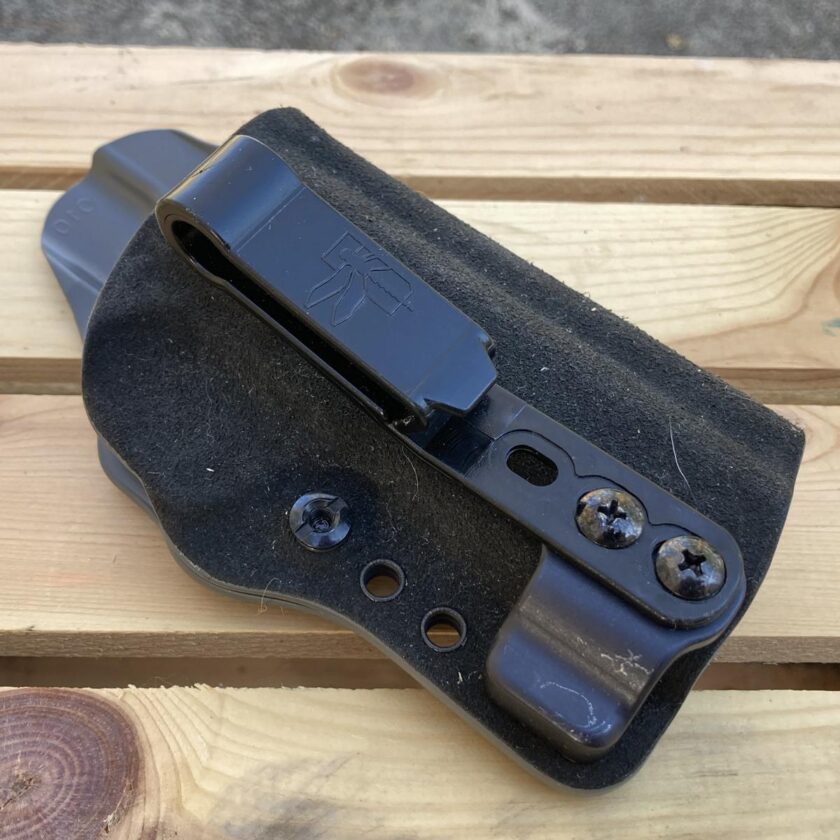
I would encourage you to have some patience with a new holster. I have put several holsters on and immediately thought, “oh crap – this isn’t going to work.” After being patient and working with the holster for a few days I could sometimes adjust it (and myself) and actually get it to be fairly comfortable. Just because you don’t immediately fall in love doesn’t mean the holster is junk – it may take a little time to get used to. Sometimes wearing one a little bit will let you get used to it and figure out some little refinements that make it tolerable or even comfortable.
But sometimes, as was the case here, it never gets good and is always uncomfortable. Sometimes despite your best effort a holster simply won’t work for you. This is why most people who have been carrying for a few years accumulate the proverbial “box of holsters” in their basement. To eliminate as much trial-and-error as possible, try out some holsters from your gun-owning friends. Spend a good deal of time reading reviews from trusted people who know what they are talking about. Find out a manufacturer’s return policy before committing; on many semi-custom holsters returns are permitted with a small restocking fee.
Belt
I hate to tell you that you’re going to have to spend even more money, but a good gunbelt is also indicated if you plan to carry. The belt is the foundation of your carry system and is important. Normal belts generally won’t support the weight of a firearm and will sag, leading to an inconsistent or sloppy draw. Dedicated gunbelts must be of an appropriate width (usually 1.5″ for wear in normal clothes) and be stiff enough to support a holstered handgun without sagging.
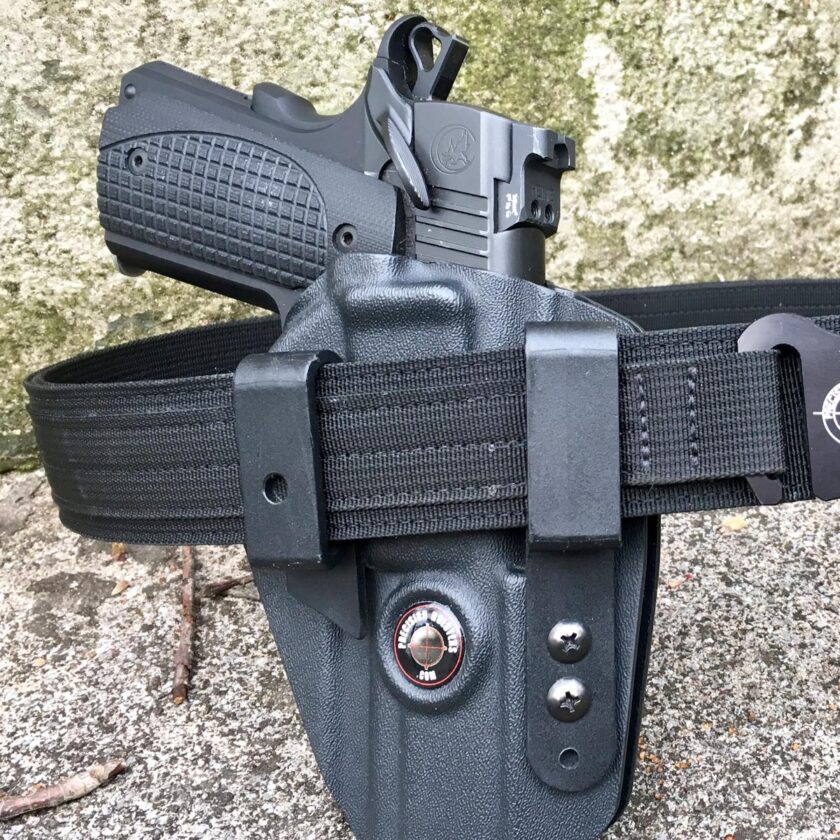
I wear a belt from Precision Holsters. One of the most popular (and coincidentally affordable) gunbelts out there is the Specialist from Mastermind (formerly Graith). Regular belts just don’t have the rigidity to support a gun and will quickly lead to discomfort and dissatisfaction with your holster. There are plenty of other good gunbelt makers out there, and belts are made in leather, too. Styles range from rugged to dressy. I’m hardly an expert on belts but I can tell you a good gunbelt makes all the difference in the world.
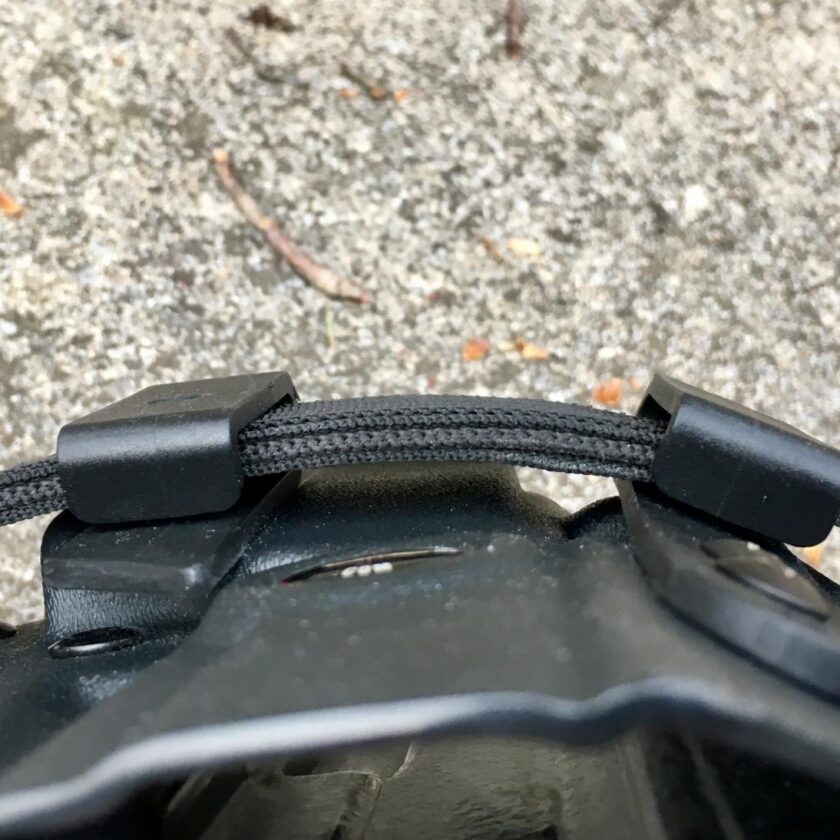
With all that stuff said, let’s talk about why a holster is so important. Then we’ll get into holster selection criteria like materials, specific features, etc.
Purpose of a Holster
If you are new to the world of handguns, holsters can seem confusing. They are everywhere. There are websites all over the internet hawking “custom made” holsters. Some cost $20 and some cost $200. Holsters can be plastic or leather or nylon. Some are “universal” holsters and some are uber-specific, requiring you choose your exact firearm, features you desire like a sweat guard or a “wing” (whatever that is), and specifics of your gun like whether you have an RMR-cut or not…
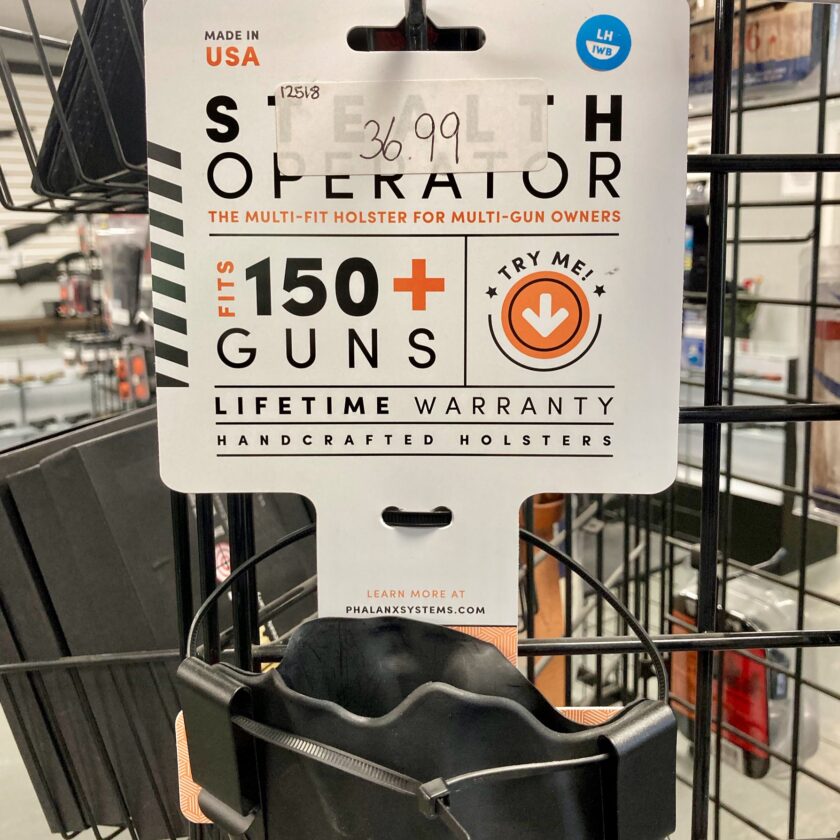
I hope this post will help you sort through the confusion and choose a holster that is right for you and your desired goals. If you stay in this world long you will probably accumulate several holsters, and honestly you may have several for every handgun you carry. I hope to take some of the guesswork out of buying a holster and help you understand the various options out there. Let’s begin by talking about the purpose of a holster and why it is so important.
Safety
Safety is a huge reason for carrying in a holster. When you carry a firearm you are carrying a tool with the capacity to kill, injure, permanently disable (we focus on the death outcome a lot, but let’s not forget severe disability in our calculus). These outcomes can happen to you, your spouse, your children, or other, complete innocent bystanders as well as the “bad guy.” Firearms safety should never be ignored. However, we only have so much attention and a holster can provide some measure of safety for us when carrying a firearm, freeing up attention for other important things. A good, correctly-fitting holster will hold the firearm securely in place, protect the trigger guard, and prevent unauthorized access, all of which contribute to safety.
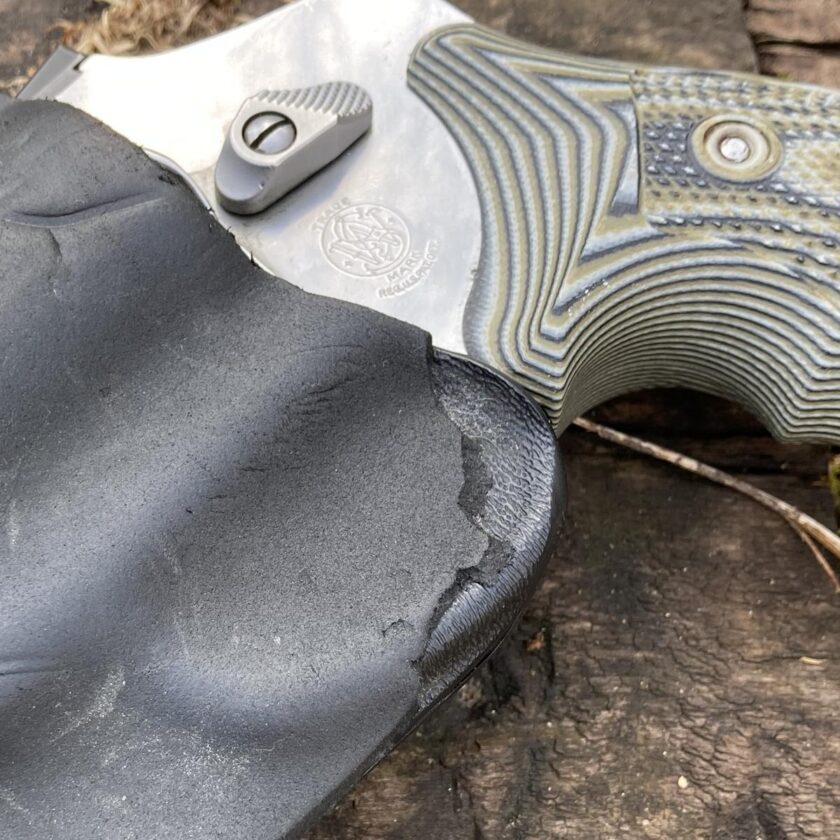
Concealment
A good holster will also help keep your firearm concealed. If you intend to carry a firearm, concealment will be pretty important to you. I remember those first few times leaving the house with a concealed handgun – I felt like every eye in public was on me. A well-designed concealment holster can make some pretty unlikely hardware completely disappear under a t-shirt. Holsters made nowadays have all sorts of neat features that help them stay concealed.
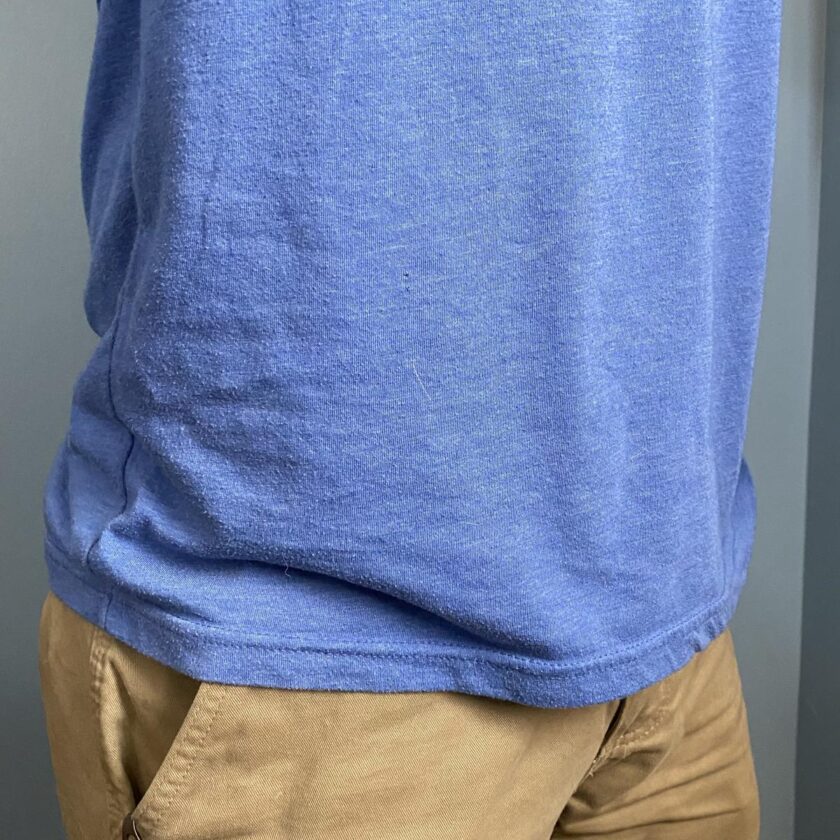
One of the things that many gun-carriers (myself included) try to prevent is “printing”. That is, showing a clear outline of the gun through one’s clothing. A good holster goes a long, long way toward preventing that by keeping the gun close to the body. There are certainly articles out there that say you shouldn’t worry about printing, but personally I want me and my girlfriend to be the only two people in the room who know I’m carrying. Sure, even if you’re printing heavily most people won’t notice but the people that do notice (the ones with situation awareness) are the ones I have the greatest concerns about.
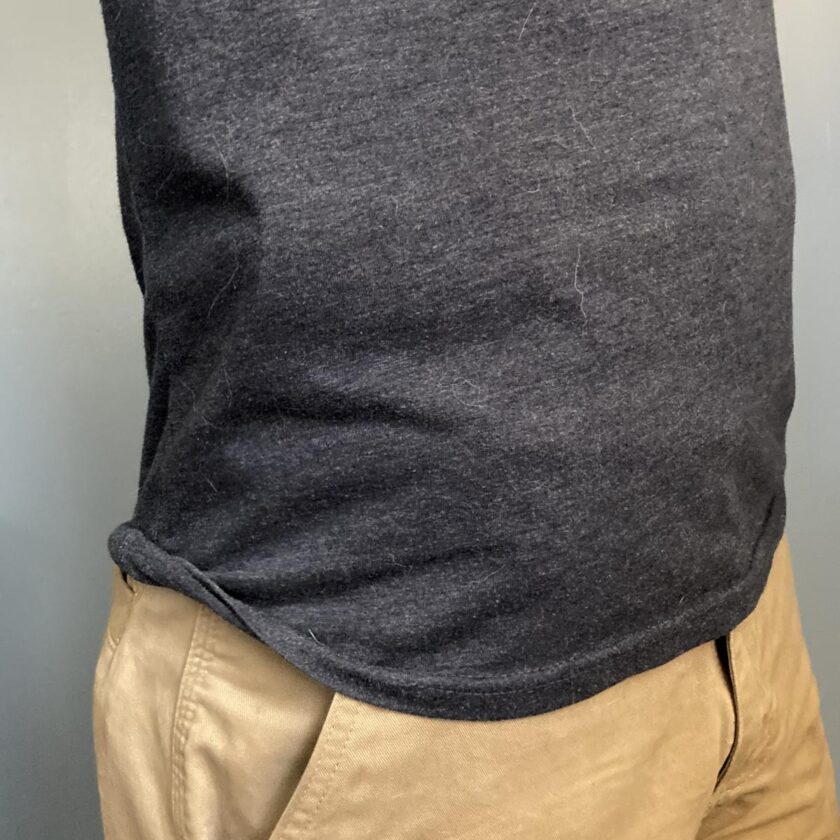
Consistency
Importantly, a holster anchors the gun in a consistent location. Consistency in training and practice is crucial to being able to perform an action on demand. You don’t want to carry your gun behind your hip one day, on your ankle the next, and in a pocket the day after that – you want to carry it in the same place day after day after day. Under stress you don’t have to think about where your hand needs to go to access your gun – it just goes there. By the same token, you don’t want a chintzy holster that flops around, always presenting the gun at a slightly different height or angle. Consistency is crucial to successful employment.
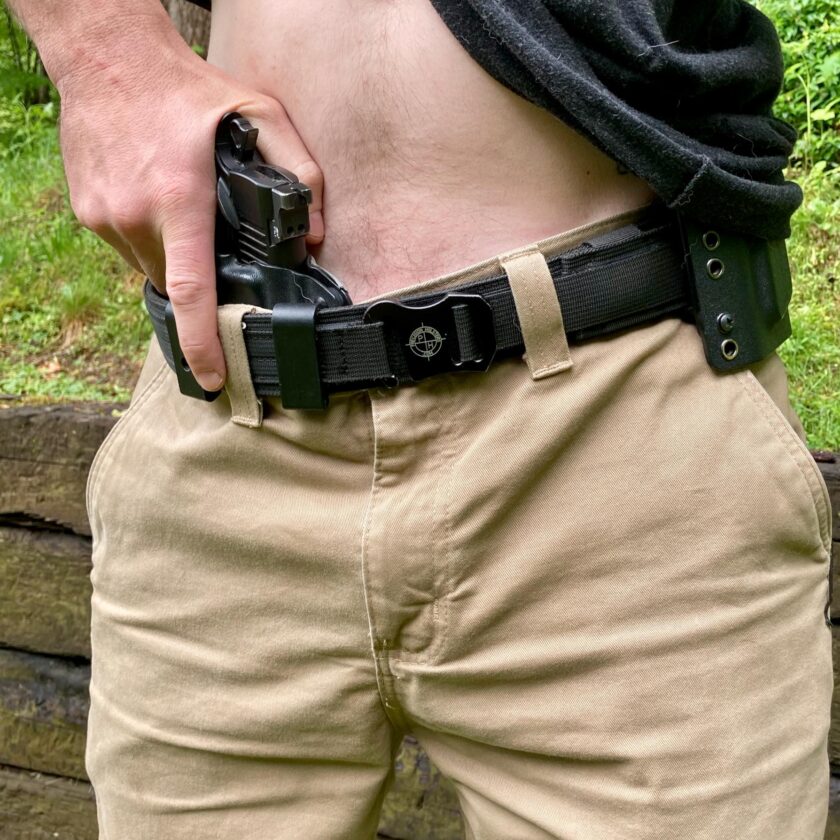
A good holster will anchor the gun solidly, providing a consistent place for your hand to go when it’s time to draw. It shouldn’t shift around fore or aft or let the grip’s angle change drastically. It should be firmly fixed to the belt and allow the gun to slide free smoothly when the time comes.
Access
A holster allows instantaneous access (at least up to your level of ability) to your firearm in an emergency. Carry in backpacks and vehicles (discussed in more detail later) is not ideal. The firearm is not retained and is probably accessible to others at various times throughout the day. It is not secured down and will become a missile in a car accident. And it is not instantly accessible – you will have to run out to your car or rummage through your bag to get your gun.
These reasons are sufficient to convince me that a holster is necessary. I hope they are enough to convince you, as well. If you have decided to go ahead with the purchase of a holster let’s look at some of the options available in a holster. But first, let’s look at the alternative to a high-quality holster setup.
A Bad Example
This post will feature a ton of great holsters and carry setups. There are many, many more holsters and holster makers that I haven’t even heard of. Now that you know what some of the features of a good holster are, let’s look at a carry setup that lacks almost all of them. Examples like this one are not terribly uncommon where I live. I don’t want to focus on the negative, so I’ll hold it to one example. I also don’t want to end on a bad note, so I’ve decided to move this up closer to the beginning of the article. Here’s our subject:
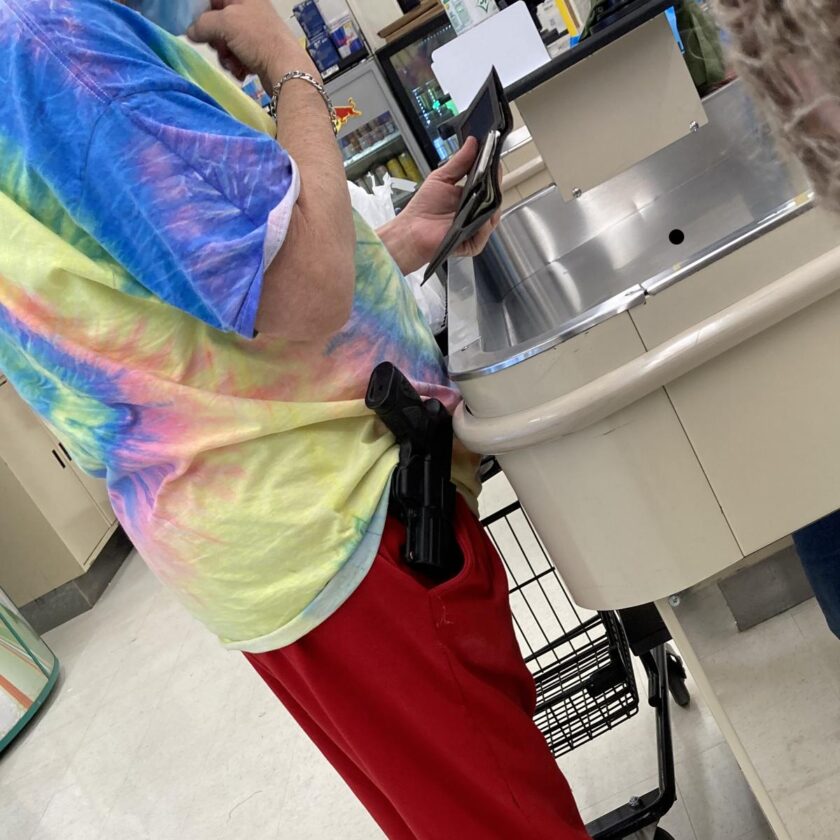
There are a few things wrong with this. First, he is carrying openly. It wouldn’t be that difficult for him to flip his shirt down over his gun. That would give him a massive advantage in surprise – I doubt anyone would suspect this dude of carrying a gun if it weren’t immediately visible. Since he has voluntarily ceded the element of surprise I’ll just tell you: taking this person’s firearm would have been no problem for me, physically. He was incredibly unaware the whole time I observed him (we happened to walk in about the same time and end up at the registers at the same time). Let’s take a closer look at his rig.
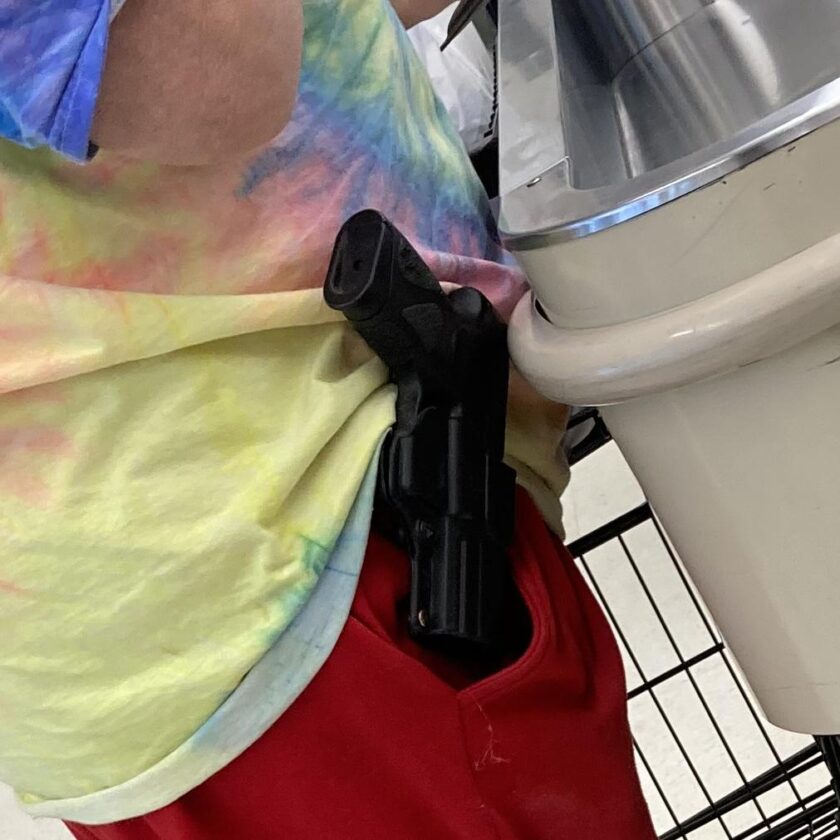
There are a number of other problems here, as well. First, his choice of attire doesn’t really support the gun. Though you can’t see it, every time he took a step the gun bobbed around. From a safety standpoint I wouldn’t want to carry in a manner that the gun was always threatening to fall off. Also, from a gun-grab standpoint, there’s nothing really securing the gun to his body – it could be easily separated from him. Simply putting on a pair of jeans could drastically increase the security of the firearm. Secondly, with the gun constantly bobbing around and shifting position it’s unlikely that it’s doing a great job of holding the gun in a consistent draw location.
While his choice of firearm (I think it’s a S&W M&P) isn’t bad the Fobus holster is crap, especially for open carry. I’ll elaborate more later but an open-carry holster should offer some active retention to protect you from gun grabs. This holster only offers passive (friction) retention.
I would strongly encourage you not to be be this guy. He’s bringing a gun into public that is plainly visibly, yet ill secured. It wouldn’t be much less secure if he left it lying in the back of his truck. This is a really, really bad example. You may be thinking, “I’m way better than that, so I’m good.” This guy is not the standard against which you should judge yourself. For many other bad examples check out Greg Ellifritz’ Don’t Dig The Rig series.
We can all do better. Here’s how.
Carry Styles
There are a million ways to carry a handgun – some good, and some objectively bad. I’m going to briefly cover the three most common styles of carry for civilian self-defense. One of these styles, or a combination of a couple should serve just about any handgun owner well (obviously exceptions always exist). Assuming quality equipment and training they are effective and safe methods of carry. Before that, let’s talk quickly about clock positions.
Clock positions: concealed carriers often reference the clock position they carry at, i.e. “I carry inside the waistband at 4 o’clock.” To understand clock positions, imagine standing above a person and looking straight down on them. Their belt-buckle would be considered 12 o’clock. Their right hip would be 3 o’clock, their spine (the center of the back) would be 6 o’clock, and their left hip would be 9 o’clock. I will use this terminology in this article, and you should understand it when consuming other holster reviews. The illustration below is from GunGoddess.com which has an outstanding article about clock positions.
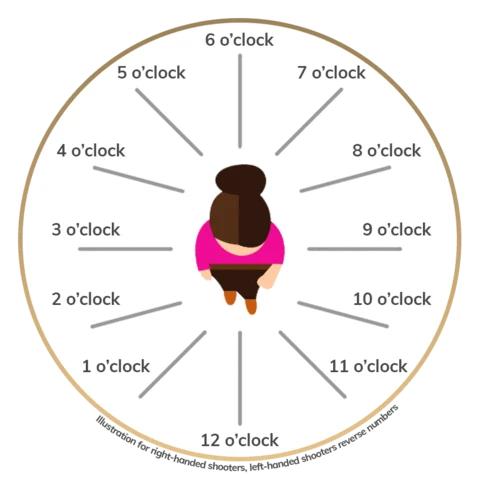
Outside the Waistband (OWB)
Outside the waistband is probably the most common method of carrying a handgun. Law enforcement officers, security guards, soldiers, and private citizens all carry firearms in this fashion. Outside the waistband holsters are also some of the most prolific holsters in the marketplace – if you head to your local gun shop to buy a holster this is – by far – what you’re most likely to find. And, carrying a gun “on your hip” is kind of iconic; it’s just sort of a natural place to put it. This was the way I most commonly carried for the first few years that I possessed a concealed carry permit.
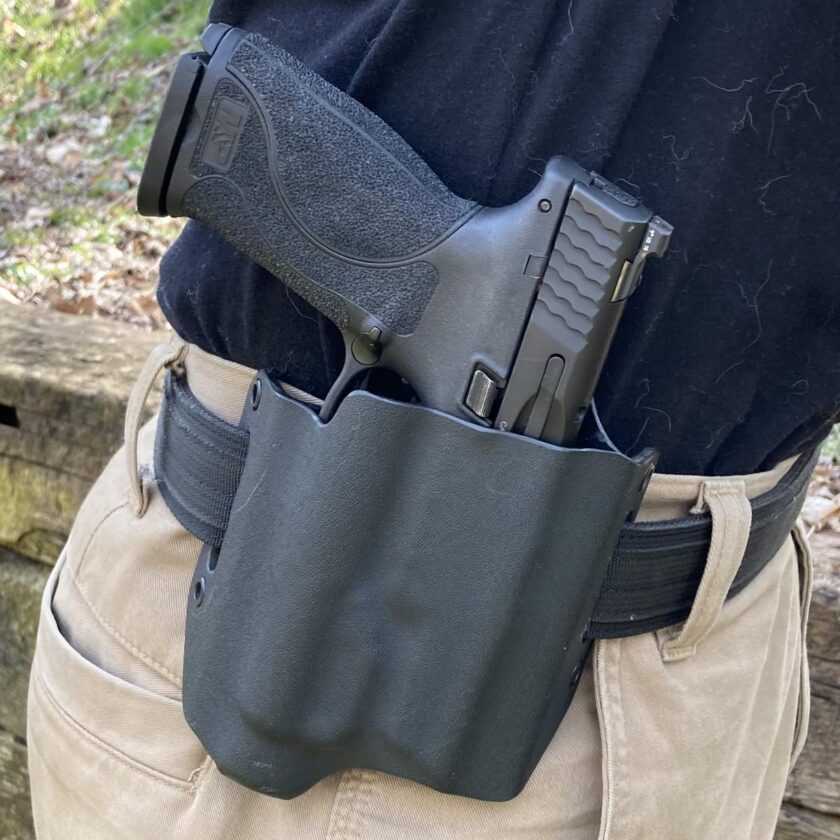
Outside-the-waistband carry has some significant advantages. It is extremely comfortable, especially if you are just getting into concealed carry. One downside to inside-the-waistband (IWB) carry is that it takes up another couple inches in your waistband, making your pants even tighter while OWB carry does not. The positioning of the holster outside of the belt line is also perhaps easier to adjust to than IWB carry. In my humble opinion an outside-the-waistband holster also does the best job of presenting the grip for obtaining a firing grasp.
The downsides of OWB carry are considerable, though. Definitionally the gun is further from your body and thus, more difficult to conceal. You also have the bottom of the holster falling some distance down on your pants where it can be revealed by the slightest raising of the hem of your shirt. Carrying outside-the-waistband at a normal 3-5 o’clock position also causes the butt of the gun to stick out quite a bit, especially when bending over. Drawing from an OWB holster is a bit slower than from some other positions, and the further back the holster moves, the more difficult it is to defend from a gun-grab.
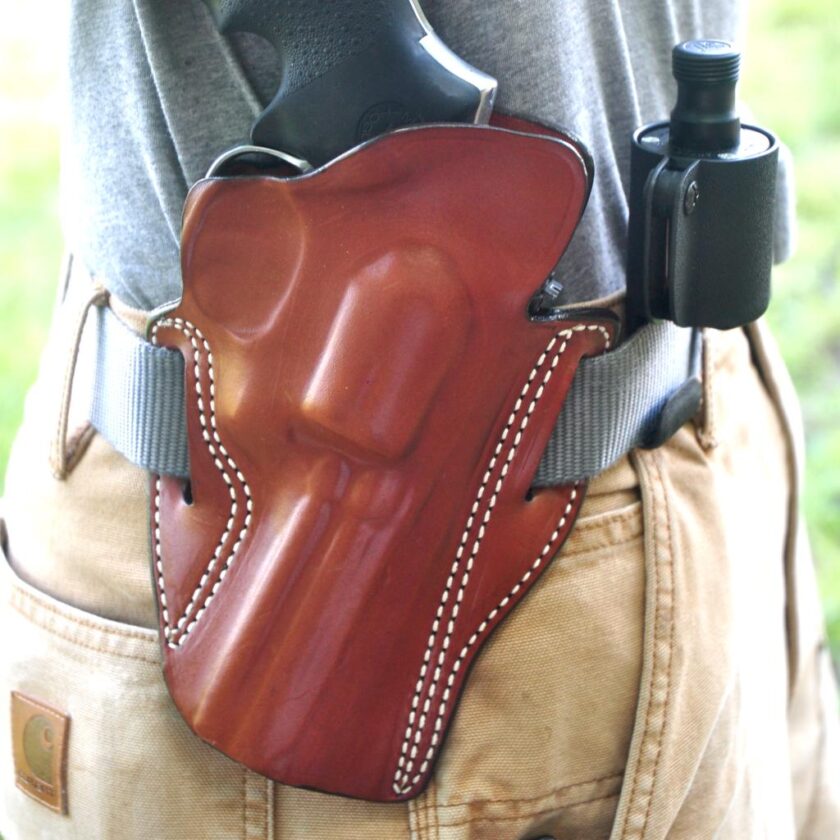
Does that mean OWB is worthless? No, I don’t think so. It is an outstanding method of carry for some situations. It would make little sense for a uniformed police officer to carry his sidearm inside his waistband. Hikers, hunters, and other outdoorsmen often carry OWB for the comfort, and because encounters with others are the exception rather than the rule making concealment less of a priority. As I will mention several times throughout this article I carry OWB when hiking and when around the house.
A classic example of the OWB holster is the Kramer Leather Belt Scabbard.
Inside the Waistband (IWB)
This method of carry involves putting the holster between the skin and your pants. It didn’t take very long after I began carrying to move to this style of carry. Inside-the-waistband carry is much more concealable than OWB carry. It puts the gun in much closer contact with the body and the constant tension of one’s pants hold the gun in place. You also don’t have to worry about the bottom of your holster sticking out under the hem of your shirt with IWB carry.
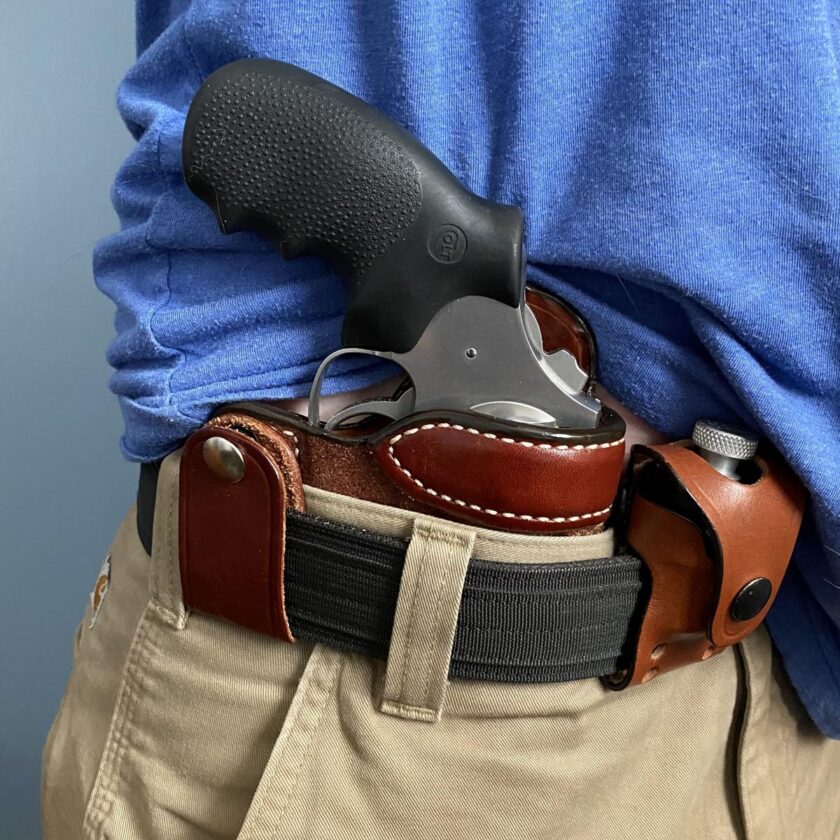
There are a couple of downsides here. First, IWB carry can be a bit less comfortable. The holster is in direct contact with your skin, and it is pulled tightly to the body. This can dig into you, especially after several hours. It can also be very hot in warmer months. Carrying IWB may also require purchasing some new pants or losing a bit of belt line. To carry in this manner you are cramming a gun and holster between your body and your pants; not many of us buy pants that are too big…at least until you start carrying IWB.
One of the most classic examples of the IWB holster is the Milt Sparks Summer Special.
Appendix IWB
Appendix carry is the carry of a firearm on the front of the body along the strong side. While standard IWB carry is usually at 3 o’clock or further back, appendix carry generally happens somewhere between 12 and 2 o’clock. This places the firearm in a position convenient for access. It is also a somewhat natural position, being the spot where bad guys – or really anyone going about with a handgun – has stuck guns for forever.
There are some tremendous advantages to AIWB carry. First, AIWB permits excellent concealment, especially with a well-designed holster. It can be truly surprising what you can hide under a light t-shirt with an effective appendix holster. Secondly, drawing from AIWB is about as fast as drawing from any concealed holster, and is faster than most. Appendix also gives you a reasonably good draw while seated compared to behind-the-hip carry positions, and you can access your firearm with either hand. Defending the holster from a gun-grab is as as easy as it can be, too. The gun is right in front of you, not behind you or off to one side. Appendix carry also lets you draw the gun discretely without the tell-tale “up and back” motion of the elbow required to draw off the hip.
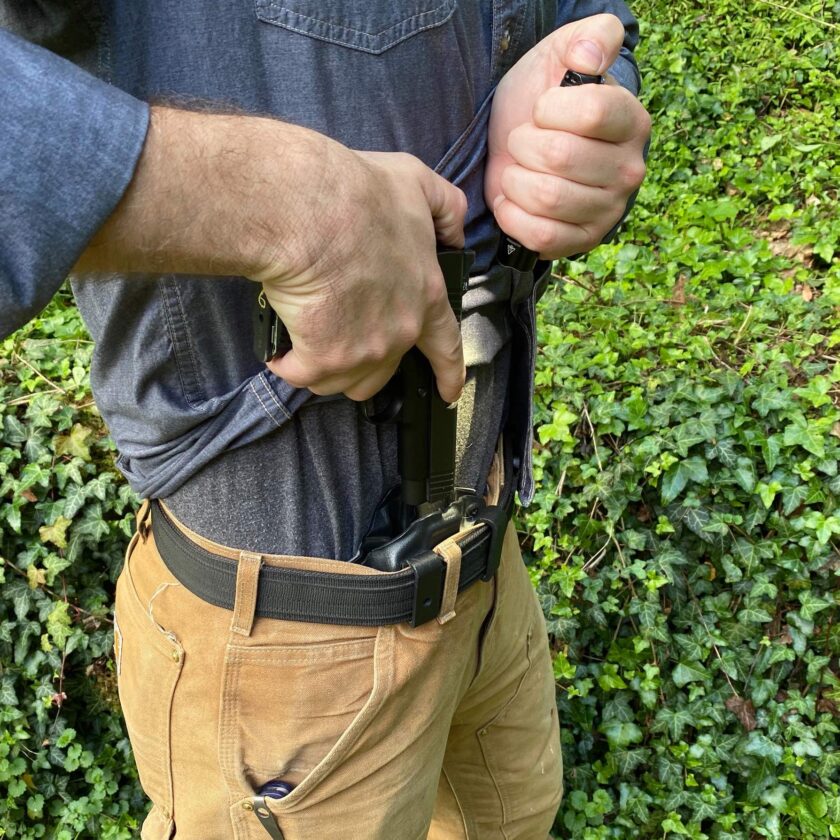
There aren’t a ton of downsides to AIWB carry. There is a lot of debate about the safety of appendix carry. Since this article is already going very long, I’m going to turn that discussion over the Chris Baker and Spencer Keepers in this video from Lucky Gunner. My biggest personal beef with AIWB is comfort; I think it requires a lot more hunting, a little more adjusting, and maybe a little more money to find a comfortable AIWB holster than it does a comfortable OWB or IWB rig. Obviously this is somewhat subjective but it has been the case for me. Since the holster is going into your pants, it will also require that there be some space in your pants, and it may not work with certain body types.
Appendix inside-the-waistband carry has a ton of advantages relative to it’s fairly limited downsides. I strongly recommend at least taking a look at AIWB carry when considering holster options; it is the way I carry 99% of the time when I am outside of my house.
A classic example of the AIWB Holster is the Keepers Concealment Keeper.
Holster Material
The next fork in the road you will likely come to is material, Kydex or leather. There are some pros and cons to each and I own plenty of both, but I’ll cut to the chase: you are probably probably best served by a Kydex holster, at least for a first holster. I will show you examples of both. There are times when one works better than the other, and I will try to point these out.
One note of caution: I would take emotion completely out of this decision. I wouldn’t carry leather “because it was good enough for dad, so it’s good enough for me.” Likewise, I wouldn’t choose Kydex because it’s all space-age and cool. I would make my choice based on a combination of objective considerations. Consider your use-case, how you carry, and what you need a holster to do.
Kydex
Kydex is a type of plastic. Kydex holsters are generally made by gently heating the material and shaping it to the firearm it will be mated to. Kydex is extremely strong, lightweight, and completely waterproof. It does not stretch and generally retains its shape, except maybe under high heat – you don’t want to leave it next to your heater or on your dashboard on a hot summer day. Because of the characteristics of the plastic it can be contorted into shapes that leather simply is not strong enough to support. Kydex also offers excellent passive retention; Kydex can be bent to clip around the trigger guard or other features of the firearm to hold it in place. This can prevent the gun from falling out if you run, jump or tussle, but still permit a clean, fast draw.
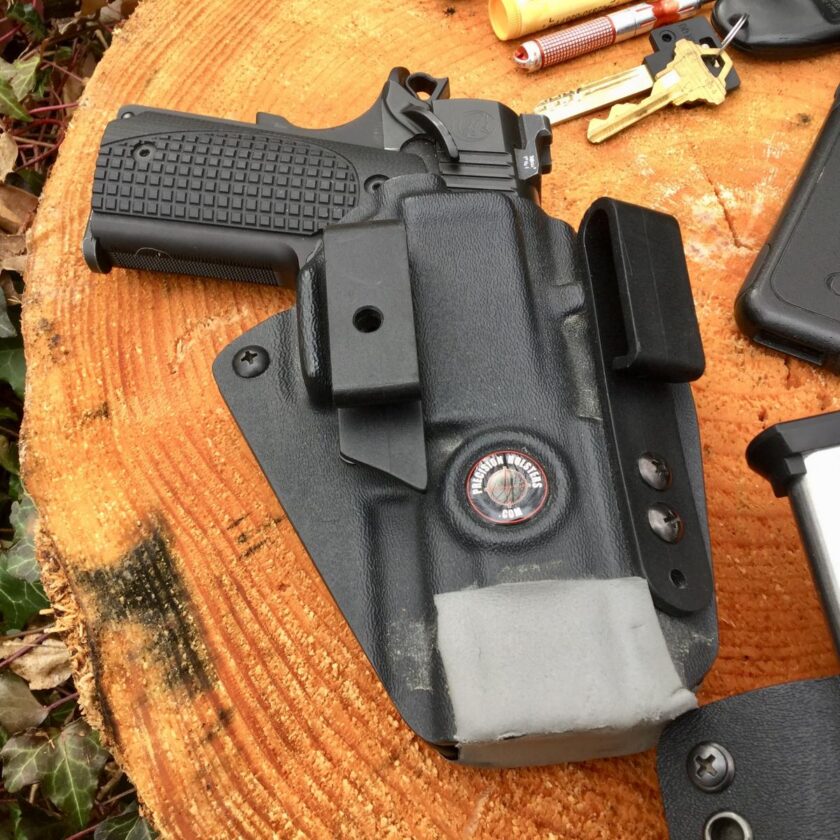
There are a few downsides, though. Kydex can be somewhat less comfortable to carry than leather. It can also be noisy (so can leather), especially when something brushes up against your holster. It’s also noisy when holstering compared to leather (a sound normally characterized by a loud “click” when the gun fully seats). Finally, I think Kydex is harder on the finish of a gun than leather is, though the amount is debatable. I’ve carried guns in both and after hours of daily carry for years both leather and Kydex ended up putting some holster wear on my guns.
Again, I think the majority of users will be best served with a Kydex holster if concealed carry is the goal. If you intend to carry strong side OWB, however, you may be better served by a leather holster.
Leather
Leather is the traditional holster material and probably what a lot of non-gun-owning folks think of when they think of a holster. Leather has a few advantages and also a few downsides, just like everything else. Leather can be very comfortable. It generally comes out of the box somewhat softer than Kydex, and contours around the body better. It also just has some traditional appeal, but I wouldn’t base my choice on that (and you shouldn’t, either). I my opinion there are more “cons” than “pros” to leather; let’s look at them.
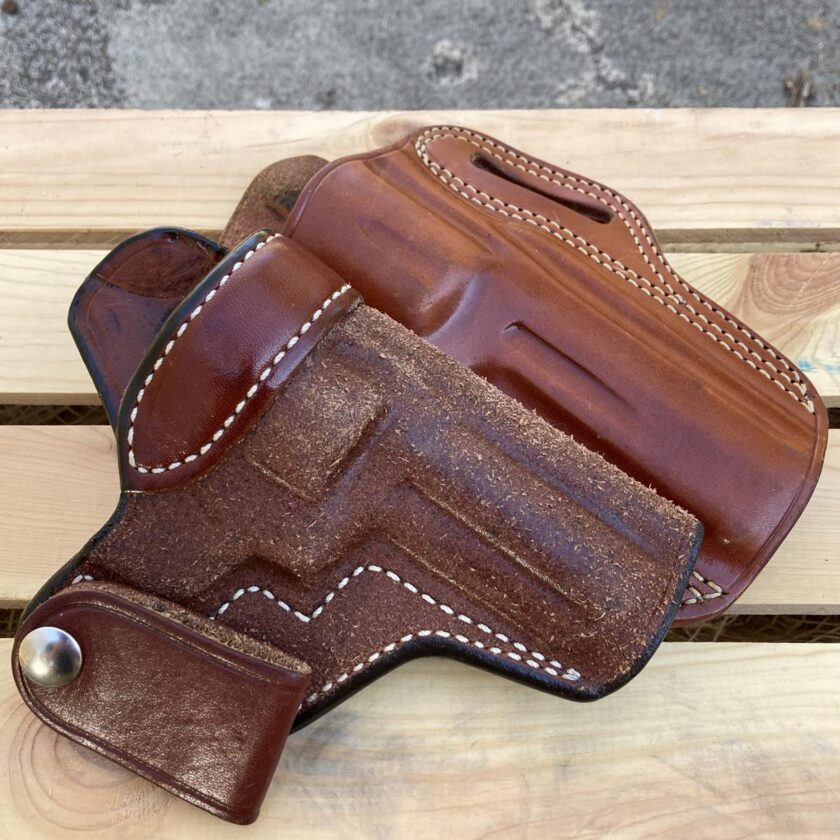
A major downside of leather is retention just isn’t as good. Leather usually has to rely on friction for retention, i.e. making the holster really tight. That works, but eventually with enough wear the holster will loosen up. Along those lines, leather stretches, wears, and is susceptible to water damage. Leather also has to be maintained, otherwise it will dry out and crack. Put too much oil on it, though, and it will become too soft and lose its shape. Leather generally just requires way more attention than Kydex.
Still, that doesn’t completely dissuade me from carrying leather. I actually use leather holsters pretty often – almost on a daily basis – for my “around the house” holsters. It’s really important to consider your use-case and what you need a holster for.
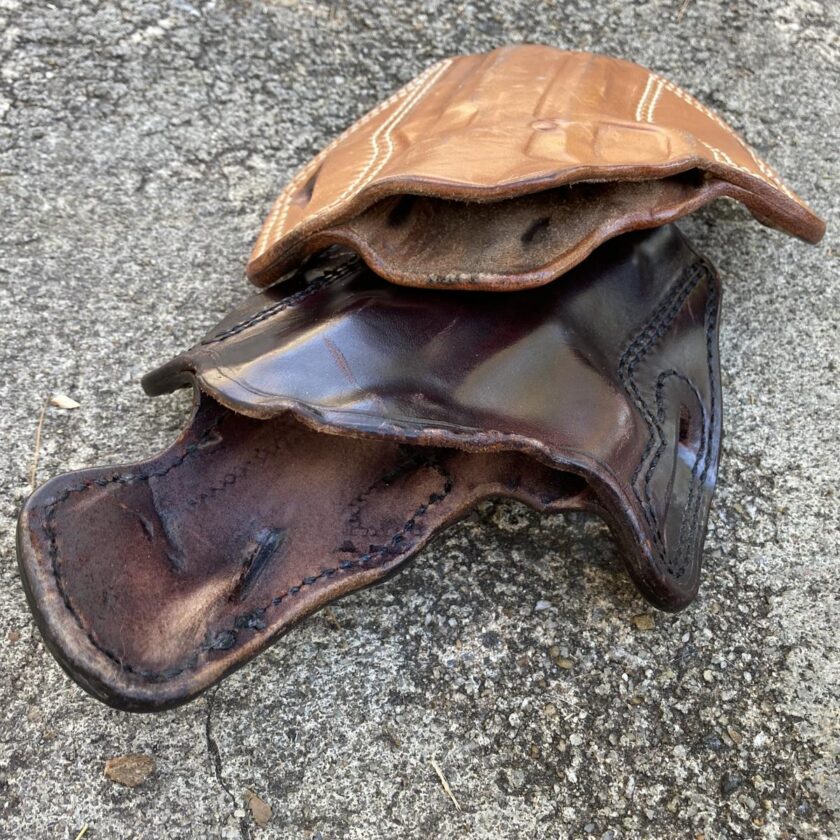
Perhaps one exception to most of the “cons” of leather is horsehide. Most leather holsters are made from cowhide. If you are willing to spend 20-30% more for a leather holster you can upgrade to horsehide. Horsehide is sometimes called “the Kydex of leather” because it is very rigid, more durable and water-resistant, and – in my humble opinion – just generally superior to cowhide. Leather can also be noisy and this is especially true with horsehide. I have couple horsehide holsters that are very creaky and constantly make noise when I sit, stand, walk, etc. but I wear them often and wouldn’t trade them for anything.
A Case for Each
I probably sound like I’m all-Kydex, all the time. The truth is I probably carry in leather as much as I do in Kydex. I prefer Kydex for most of my true concealment needs, especially when going outside my home. Kydex won’t lose its shape, won’t soak up my sweat, holds the gun firmly, and permits a clean, consistent, fast draw. I also use Kydex in some non-concealment holsters, such as those on gunbelts where ruggedness is desired.
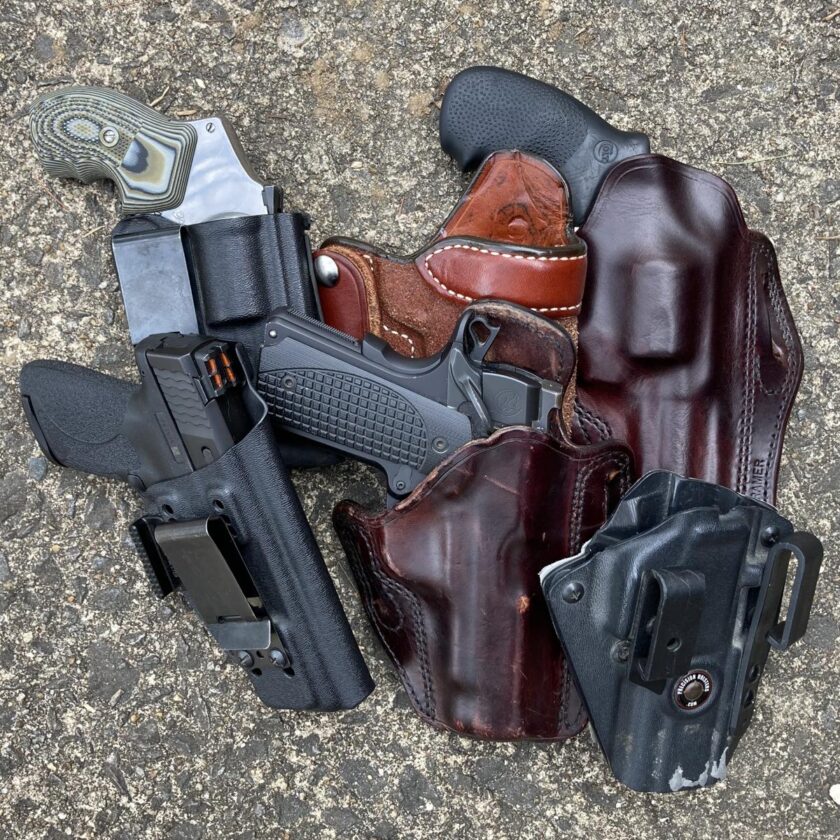
I do use some leather on an almost daily basis, though. When I am around the house I carry outside the waistband. I still conceal around the house, but concealment is far less important. There is almost no one to see me if my gun is exposed, and pretty much zero consequences if they do. For OWB carry I still prefer a leather scabbard. It protects the gun well, still allows reasonably fast access, and is comfortable no matter what I’m doing – from collecting eggs to cutting wood to garden work to sitting on the couch reading. I also have a couple other leather holsters, including an inside-the-waistband holster for a revolver that I sometimes carry, but for which Kydex holsters are impossible to find.
Cost Difference
I almost made a price comparison between the two materials, but I don’t think it’s there. You can easily pay $100-150 for a good Kydex holster, just like you can a good leather holster. I just don’t see an appreciable difference between the two and except for outside cases, that probably won’t be the difference-maker for you. And remember: cheap is cheap. Cheap leather is cheap for a reason, cheap Kydex is cheap for a reason.
I’m not saying you can’t find quality holsters that are also inexpensive. Some manufacturers do so much volume that they are able to sell holsters a bit more inexpensively. Galco (leather) and JM Custom Kydex are two really good examples of high-quality holsters that don’t cost a fortune. Do your due diligence before spending a fortune on a holster and you should be well served.
Materials to Avoid
There are plenty of other holster materials out there, but most of them are probably best avoided. Probably the next-most prolific material is nylon. These are the true bargain-basement of holsters and should be avoided at all costs (with very few exceptions, like the excellent DeSantis Nemesis pocket holster). Holsters of this nature are usually very soft. This creates a floppy holster that does not provide a consistent draw, does not permit one-handed holstering, and may not protect the trigger, even when the gun is holstered.
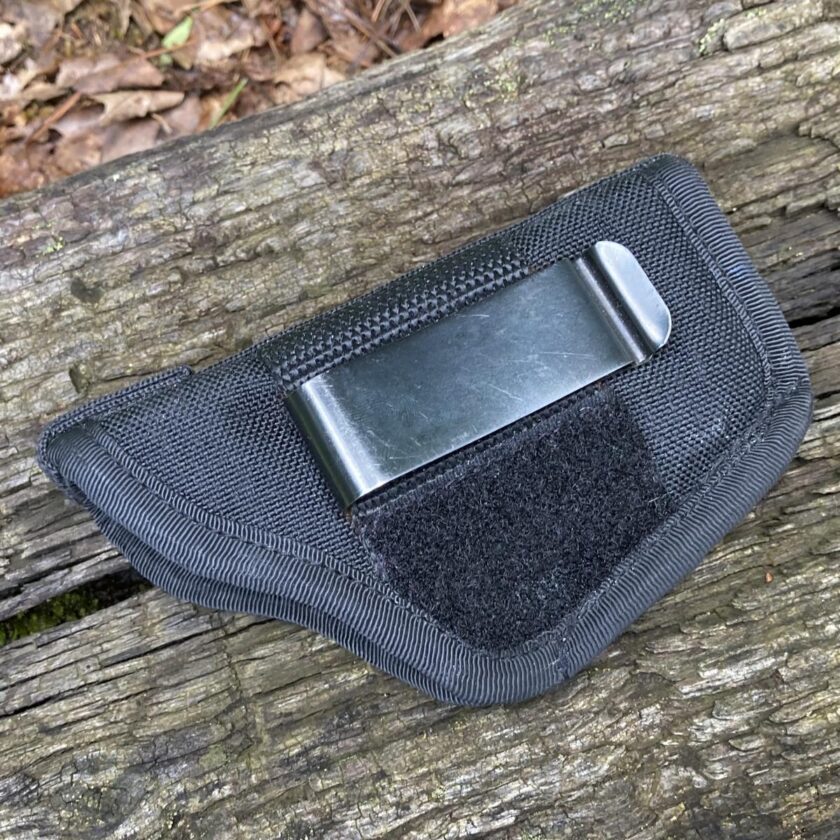
Hybrid holsters: Some manufacturers (notably Aliengear and Crossbreed) attempt to get the benefits of both leather and Kydex by making hybrid holsters. A hybrid is a holster that is constructed of both of the two materials. Generally there is a Kydex shell that covers the outside of the pistol with a leather backer that sits against the wearer’s body. The Kydex half-shell provides most of the benefits of a Kydex holster while the leather backer provides user comfort.
It’s a great idea in theory but I generally do not recommend hybrid holsters. Hybrids are famous for failing when the leather inevitably softens, compromising the security of the firearm. That said, I have effectively zero experience with hybrid holsters. Their failure mode is fairly well-documented, though. If someone wants to send me one to try out I’m glad to give it a fair shake.
Manufacturer Recommendations
There are a million-and-one Kydex benders and leather workers out there. I’ll list a few really reputable ones. I own some of these holsters, and others I am recommending by reputation. Between these manufacturers you should be able to find just about anything you need for just about any reasonably popular handgun. Also please note there are tons – TONS – of other excellent manufacturers out there. I can’t name them all, but just becasue they aren’t on this list doesn’t mean I don’t like ’em.
- Kydex: Dark Star Gear, JM Custom Kydex, Keepers Concealment, PHLSter
- Leather: Andrews Leather, DeSantis Gunhide, Galco, Kramer Leather
Common Features, or What Makes a Good Holster
Now that you’ve hopefully decided on a material for your holster, let’s talk about some features you should look for in your new holster.
Trigger Protection
A holster should protect the gun’s trigger. That is, it should prevent foreign objects from being able to get to the trigger. Why? An exposed trigger brings about the potential for it to get snagged on protruding objects: branches, draw pulls, etc. If the trigger is snagged and pulled sufficiently to the rear… Well, you know what happens. Generally speaking we want a holster that completely covers the trigger guard. Material around the trigger/trigger guard should also fit well and be rigid. Some holsters may provide total trigger guard protection but still fail to offer a meaningful measure of safety. If the fitment is poor, objects can still potentially make their way in and around the trigger guard. If the material is too flimsy objects may be able to manipulate the trigger through the holster.
Retention
I’ve mentioned this a couple of times already, but the holster should retain your firearm. That is, if you run, jump, are tackled, or trip and roll down a hill, your firearm should stay firmly in place. It shouldn’t go skidding across the pavement, or rolling the rest of the way down the embankment into the river, or be floating inside your shirt as you try to get back on your feet. An easy way to test this is to put your UNLOADED gun in the holster and hold it upside down above a bed or other soft surface. If the gun doesn’t fall out, great! Give it a little bounce up and down. If the gun still doesn’t fall out you probably have adequate retention FOR CONCEALED CARRY. Please note that this is not the same thing as retention in the context of open carry and defeating attempts to disarm you. The point is, you should never be worried about your gun falling out – that’s very, very bad business.
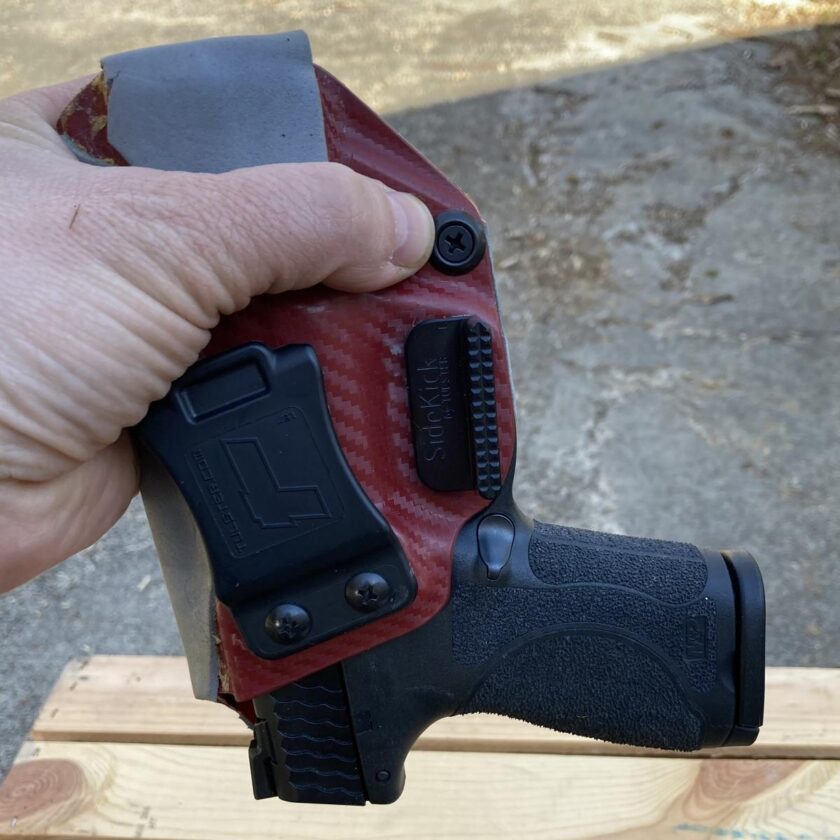
If you don’t have adequate retention but have a Kydex holster, you can very likely adjust the tension of the holster. Check to see if there are screws near the margins of the holster or near the trigger guard. Usually tightening these screws a little bit at a time can adjust your tension to within acceptable limits. Don’t tighten your holster to the point that you can’t draw the gun effectively. Very few leather holsters have a similar feature.
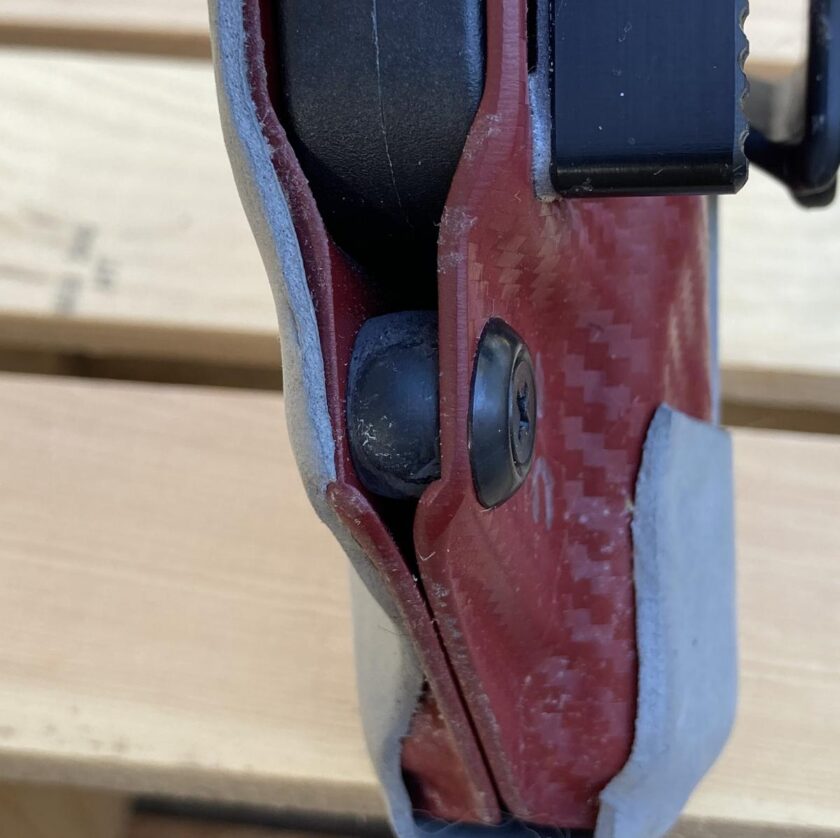
A more common retention feature in leather holsters is some sort of retention strap like a thumb-break. A thumb-break is a strap that snaps closed, usually behind the hammer, holding the gun in the holster. It is called a “thumb-break” because the snap is located where the thumb naturally falls when drawing. The thumb “breaks” the snap open allowing the gun to be drawn. Though I don’t prefer them, thumb-breaks can still permit an extremely fast draw.
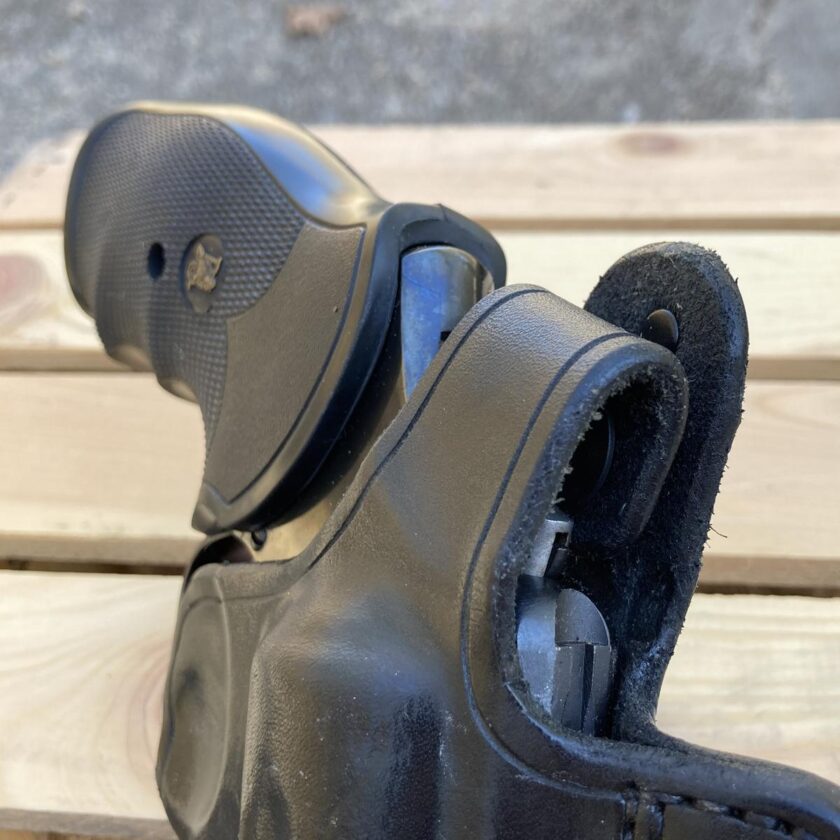
Be wary of other types of strap over the back of a holster, though. Some holsters – and this seems to be especially common with very inexpensive holsters or “universal fit” holsters – have a strap that runs over the back of the handgun but does not easily release. These may seem like a good idea but are terrible in practice. There is no easy, fluid way to defeat such a retention method in tandem with a smooth draw stroke. Avoid at all costs.
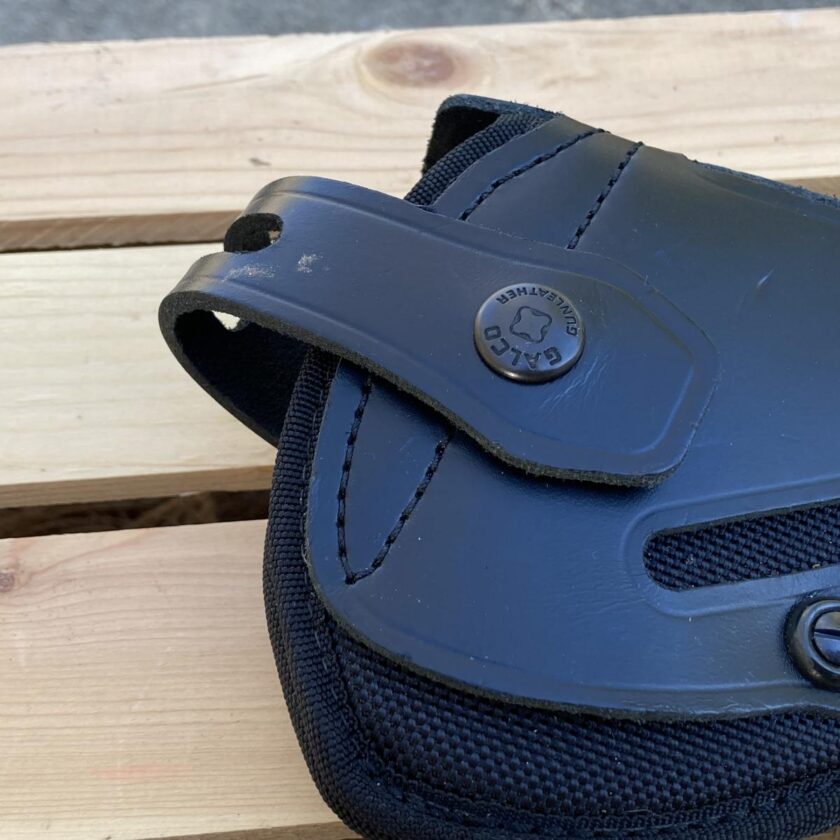
And speaking of things to avoid… You should avoid holsters that require the trigger finger to press some sort of button or lever to draw the gun. The most notable example of this category is the Blackhawk SERPA holsters. I still see this regularly, including on the hips of local law enforcement officers, but popularity does not equal quality. Here is a massive article detailing the failings of the SERPA holster. Fobus a company known mainly for producing cheap, poor-quality holsters, also sells a similar product. I strongly recommend avoiding these holsters.
Comfort
A good holster should also be comfortable. I have owned some very uncomfortable holsters. This may seem like a secondary consideration but I promise you, it is not. No matter how committed to concealed carry you are, you will only endure an uncomfortable or painful holster for so long before giving up. This can be extremely disappointing to new concealed carriers, and a reason that some give up after a few weeks of “enduring” their carry gun.
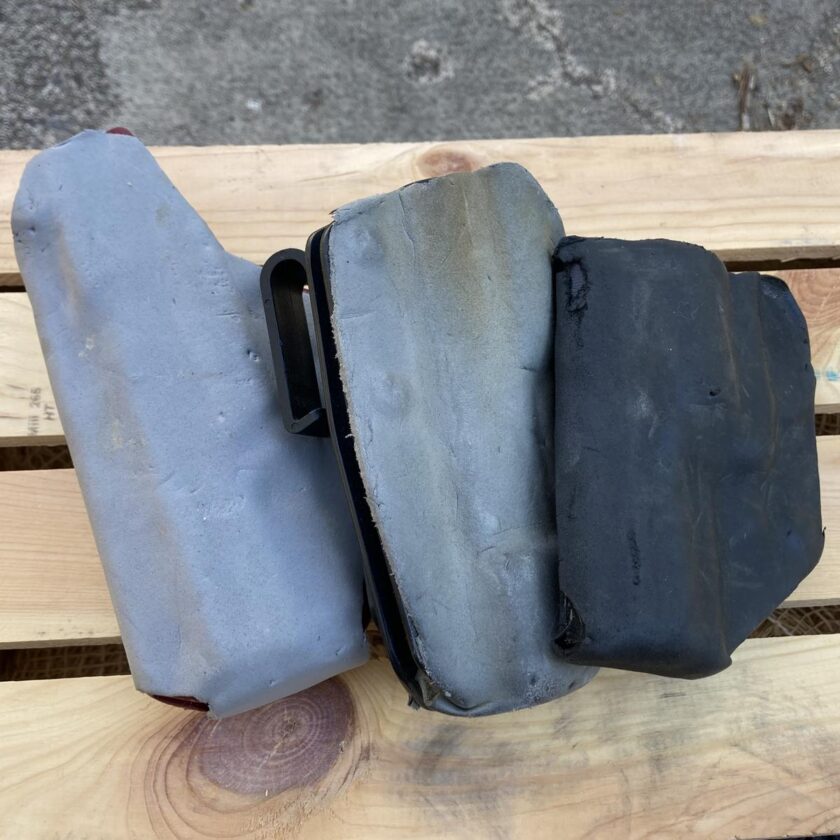
I strongly recommend finding a holster that is comfortable to you. Unfortunately there is no magic sauce to determining what will be comfortable for you and what won’t. Some experience will be necessary to figure out what really works. Generally, high quality holsters from the manufacturers I listed above should be reasonably comfortable. Using an appropriate belt (an actual gunbelt) and appropriately fitting pants will help, too. Working with positioning and adjustable features like ride-height may help, and adding padding to the back like I commonly do might help, too.
Holsterability
I just coined a term! Just kidding…but seriously, you should be able to holster your firearm with one hand. When you withdraw your gun from the holster, the mouth of the holster shouldn’t collapse, it shouldn’t disappear under your belt line, or do some other thing that requires your support hand to holster. First, if you’ve been in a deadly force confrontation, you may not have two functional hands with which to holster. Second, you may need your non-shooting hand to do other stuff, like stay on the phone with 911 (because you don’t want to be standing at the scene of a shooting with a gun in hand when the police roll up). Third, putting your support hand down around the mouth of the holster to open it up almost guarantees you’re going to point your gun at your own hand.
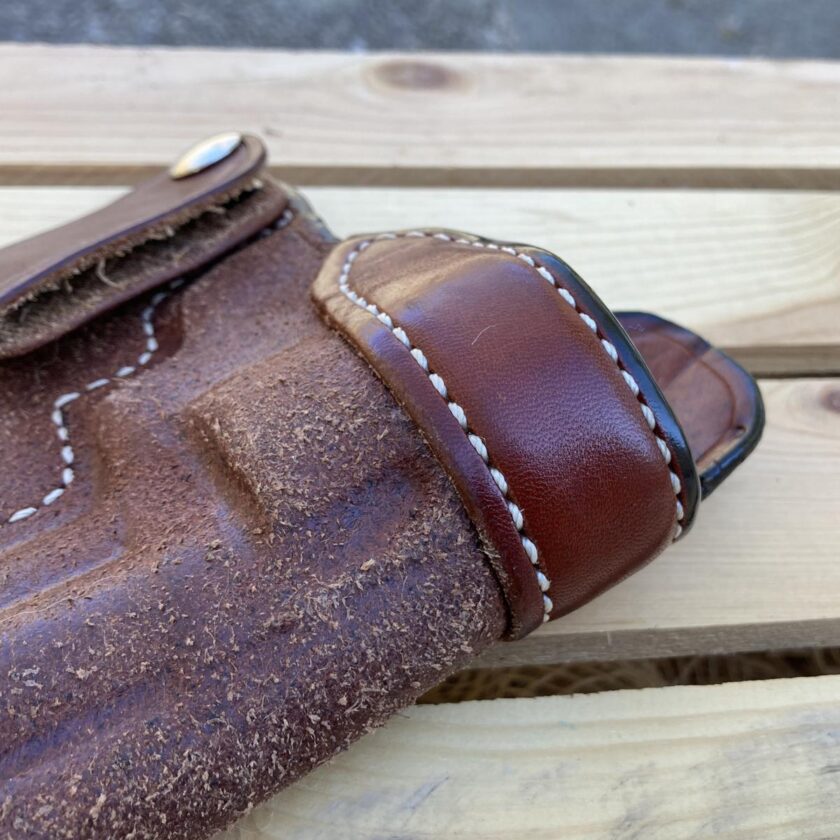
Kydex is very good for this – generally Kydex is rigid enough that it won’t collapse at all. Leather can be made good at this. Some leather workers will double or triple the thickness of leather in the holster’s mouth. Others will go so far as to put a steel band in the mouth of the holster. Regardless of how you get there the holster should retain its shape, stay open, and stay in position when the gun is drawn.
Belt Attachment
Most holsters will attach to your belt in some form or fashion. Of course there are exceptions to this rule, but generally a holster will attach to your belt via belt hooks or loops. Generally outside-the-waistband holsters have belt loops that the belt runs through. Inside-the-waistband holsters generally have loops or clips that run over the waistband and secure themselves to the belt. A belt attachment should keep the holster secured to your person at all times. It should never accidentally come undone, and you should never draw the holster out with the gun. Let’s look at several belt attachment methods.
Loops: This is the most secure form of belt attachment, as the belt runs through it. One important note on belt loops: one size does NOT fit all. You should order a holster with belt loops that are sized to fit your belt. Loops are extremely common on outside-the-waistband (OWB) holsters. Outside of a few specialty designs, like paddle holsters, most OWBs will have belt loops. Loops are somewhat less common on inside-the-waistband (IWB) holsters. On many IWB holsters with loops, the loops are secured with a snap, allowing the user to put the holster on and/or take it off without removing his belt. Below are a couple examples.
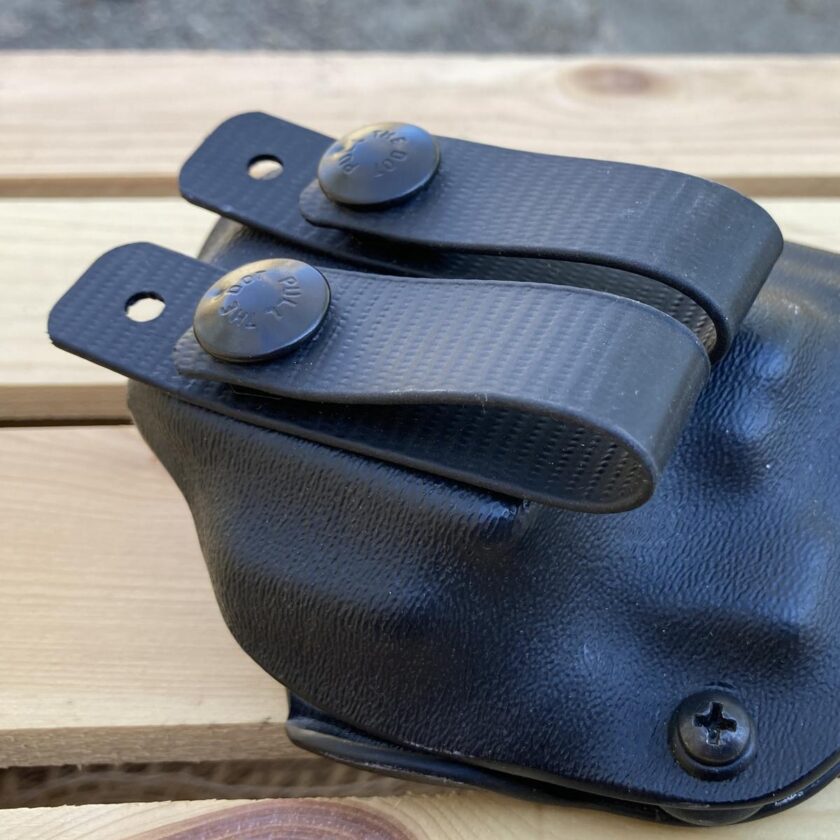
Of course loops come in different styles. Loops can be soft or had. Loops can have a snap, allowing the holster to be removed from the belt easily, or they can be a solid loop that you have to run the belt through.
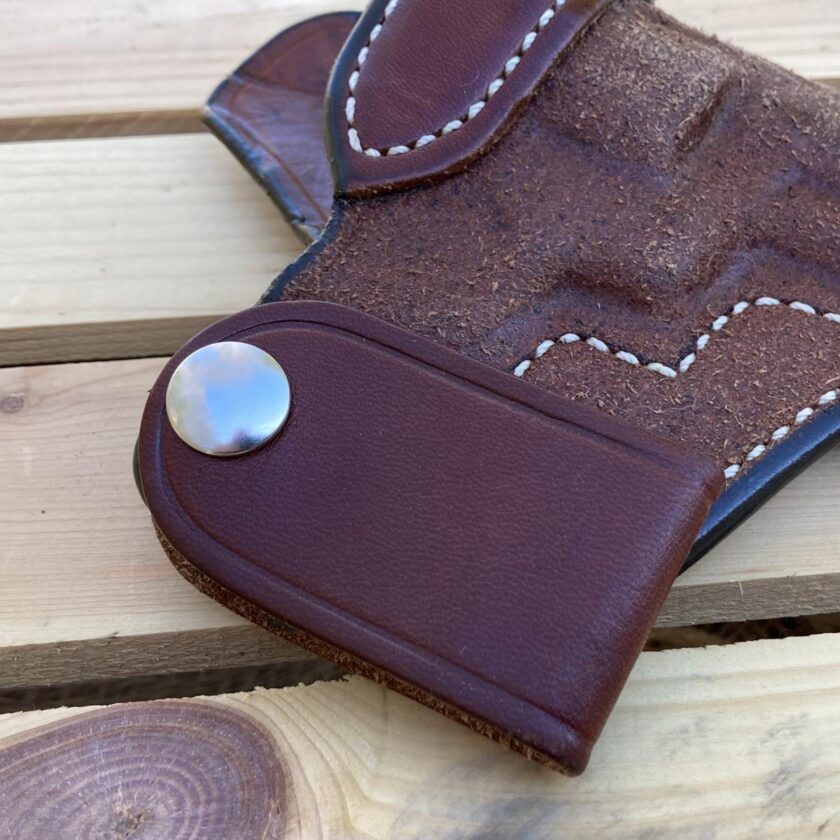
The loop on Keepers Concealment holster below is a hard loop that requires unbuckling your belt to don or doff the holster. This is more solid than a soft loop and guarantees that the holster won’t “come undone,” but is also a bit more inconvenient.
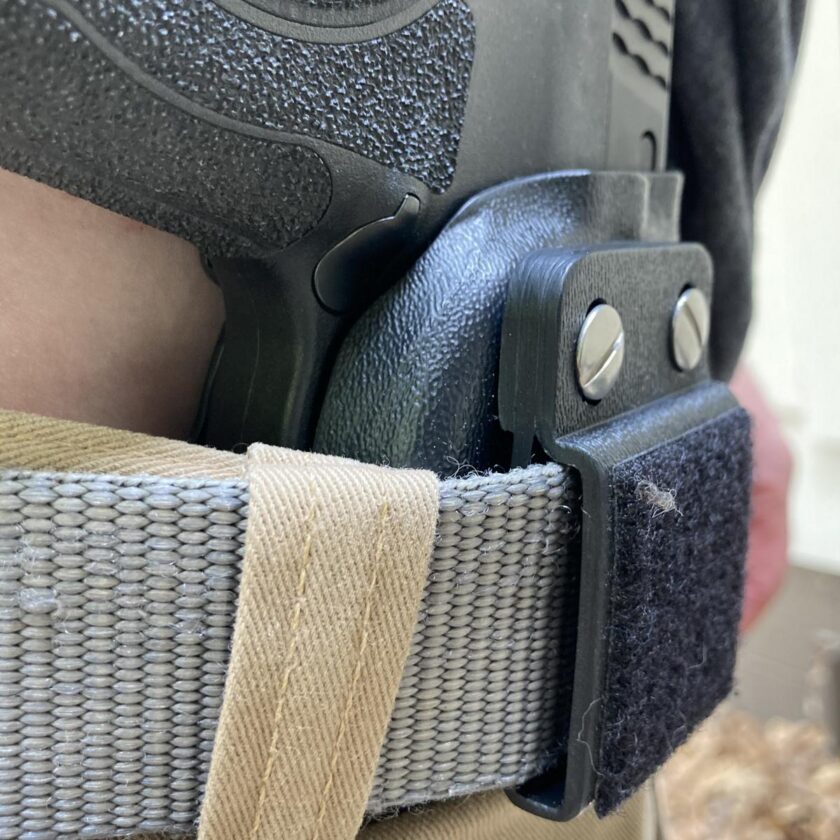
Clips: Another method of anchoring a holster to a belt, especially a IWB holster, is clips. Clips are extremely popular because the go on and off the belt very quickly. They also have some downsides – a clip that comes off too easily may come off with the gun when drawing. A good clip will have some sort of underbite that holds onto the belt when it is pulled upward. Below are some examples, some great, some decent. Clips may be either metal or plastic and like loops, may be single or dual. Metal clips are strong, springy, and have the advantage of being very thin.
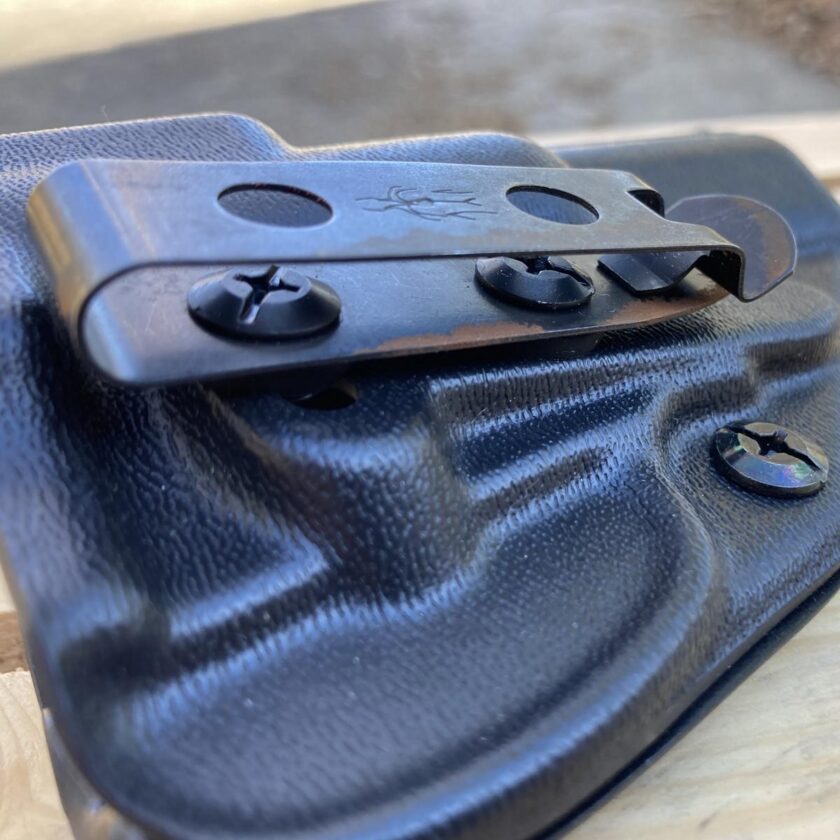
Plastic clips are probably the most common method of attaching an IWB holster. They are also probably the least favorite because they can sometimes slip off of the belt, especially if poorly constructed. The holster below is my primary EDC holster, a Precision Holsters’ Ultra Appendix. After going on three years of carrying this holster I’ve yet to have a clip release when it wasn’t supposed to. On the other hand I’ve never worn it with anything other than a proper gun belt, which helps.
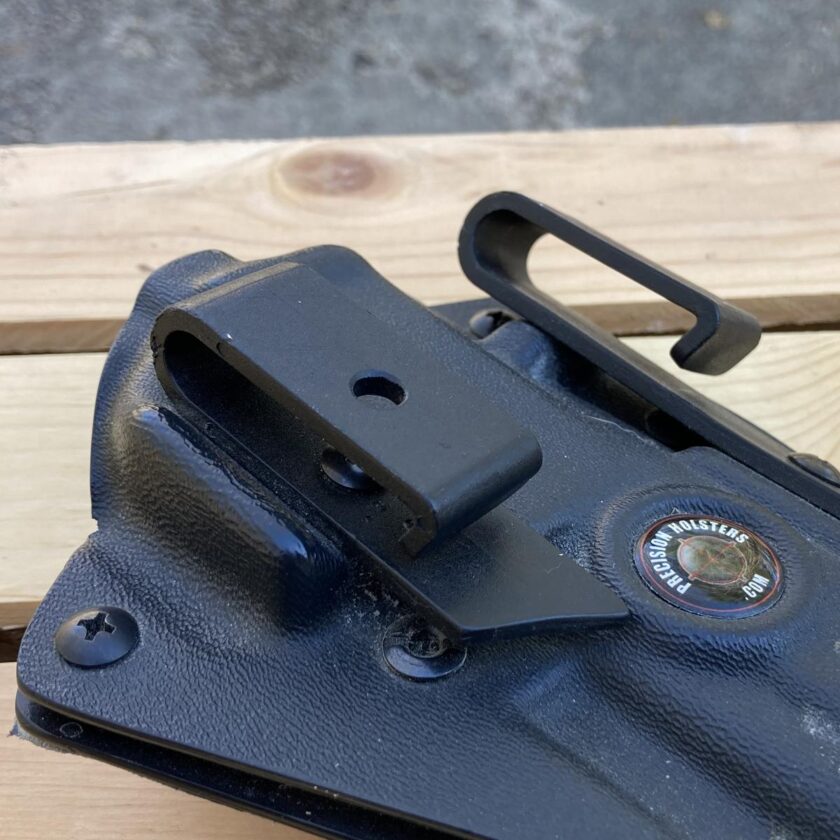
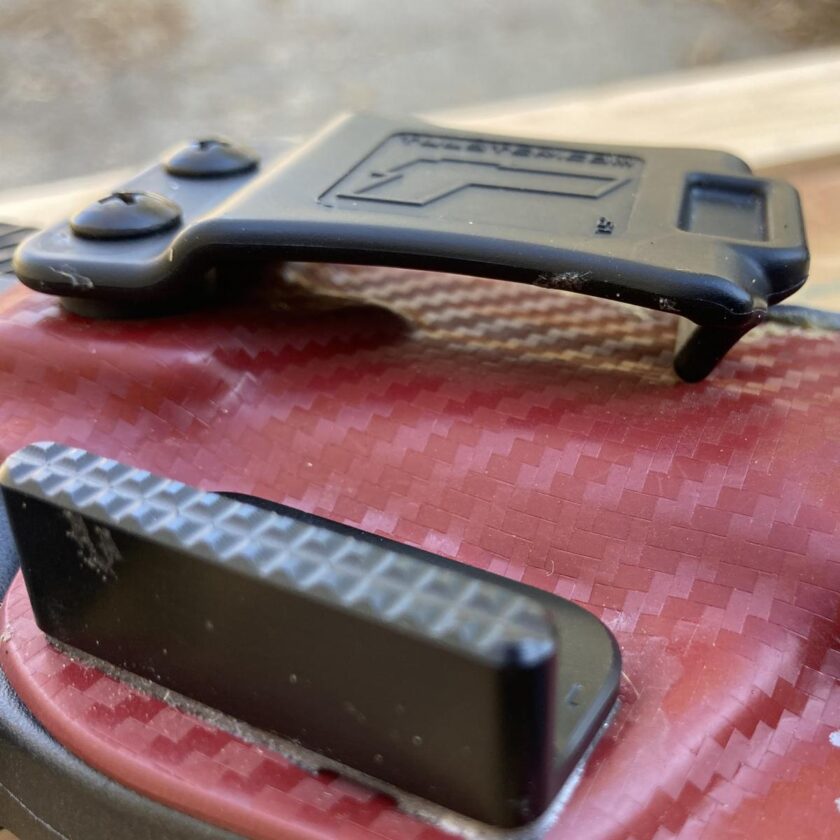
Tuckable Hooks: Some inside the waistband holsters have a “tuckable” strut with a hook that allow you to tuck your shirt in over the holster while still allowing a hook to catch on the belt. This allows concealment in dress that requires a tucked-in short. Carrying in such a configuration produces a slower draw than carrying with an untucked shirt but it may be indicated in certain situations.
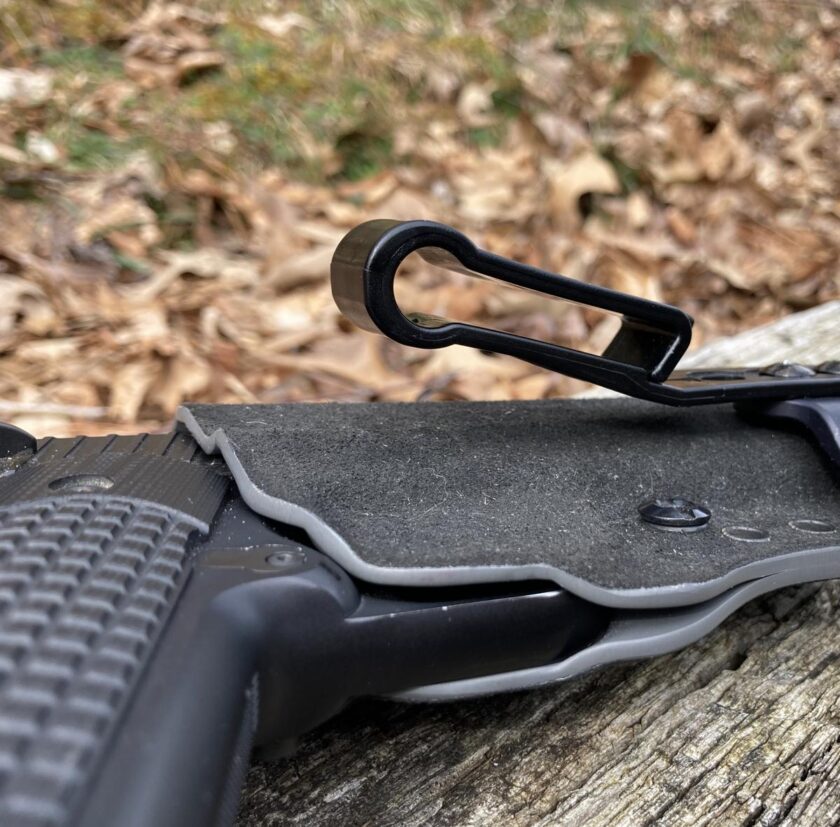
I don’t have much need for this type of holster currently. However, I have spent a considerable amount of time wearing a tuckable holster with a tucked in dress shirt. During many of my classes I wore jeans with a tucked polo or dress shirt. I stood in front of hundreds of classes for eight-to-ten hours days, for five days, and was never once called out on having a gun. That’s not an ironclad guarantee no one noticed, but it suggests that my firearm wasn’t obviously visible. Though I’d prefer not to have to wear one, tuckable holsters can definitely work.
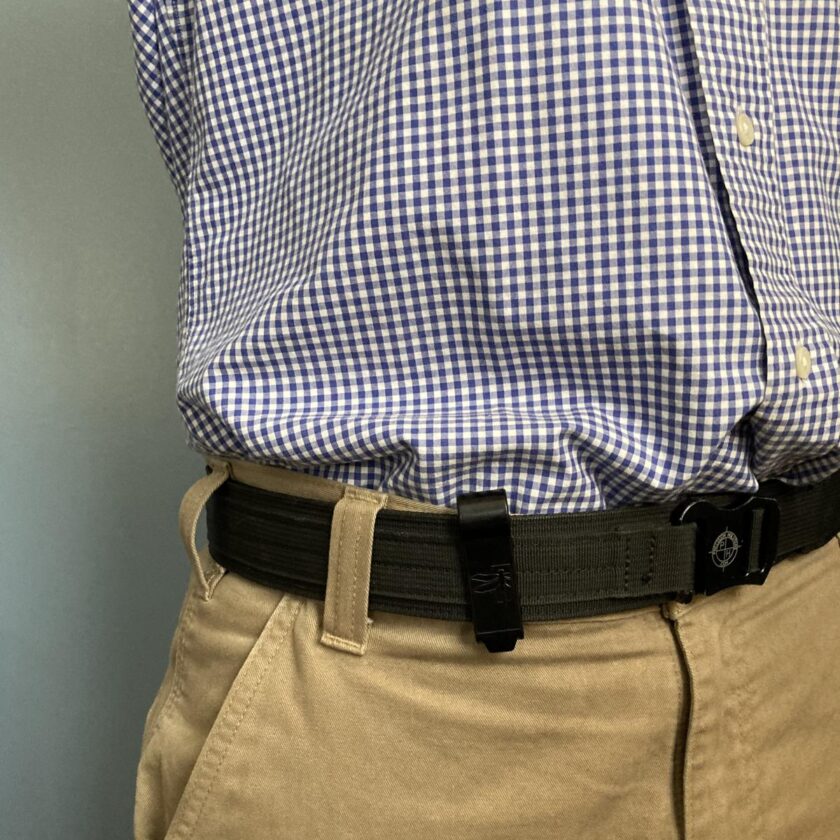
Exceptions: Obvious exceptions to this rule are holsters not carried on the belt area, like pocket- or ankle-holsters. A less obvious exception is paddle holsters. These have a rigid paddle that it between the pants and the body that serves to anchor the holster. The primary benefit is easy of donning and doffing (getting on and off) but that’s about it. Since they are usually only held on by friction these holsters – with the gun included – can be ripped from the belt. I would generally recommend avoiding paddle holsters.
Some Other Features
There are some other features you may consider, on a case-by-base basis. While the features listed above should be pretty much universal, these are more holster-specific. They should be based on the particulars of the holster you are considering and your style of dress when wearing it
Ride Height/Depth: Holsters have variable ride-height. This is the height of the grip above the belt line. A ride that is too high will cause the gun’s grip to swivel outward, compromising concealment. A ride that is too low causes difficulty in drawing. Ride height should be a Goldilocks measurement: just right, without going extremely high or extremely low. The photo below shows a JM Custom Kydex holster that didn’t quite work out for me because it carried the gun a bit too deep in the beltline.
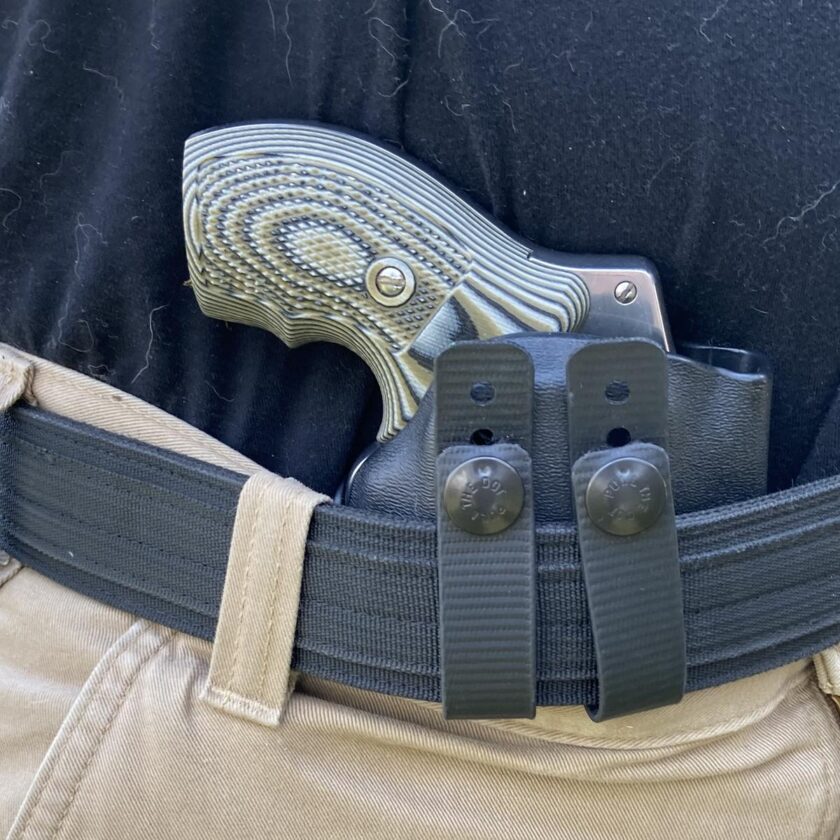
The next photo (below) shows a Dark Star Gear holster that is my Goldilocks for this S&W J-Frame revolver. The gun is low enough that it doesn’t lever the grip outward. It’s high enough that I don’t have to get my hand into the belt line to obtain a firing grasp. By outward appearances the differences between these two holsters doesn’t seem to be great, but small things add up to big results.
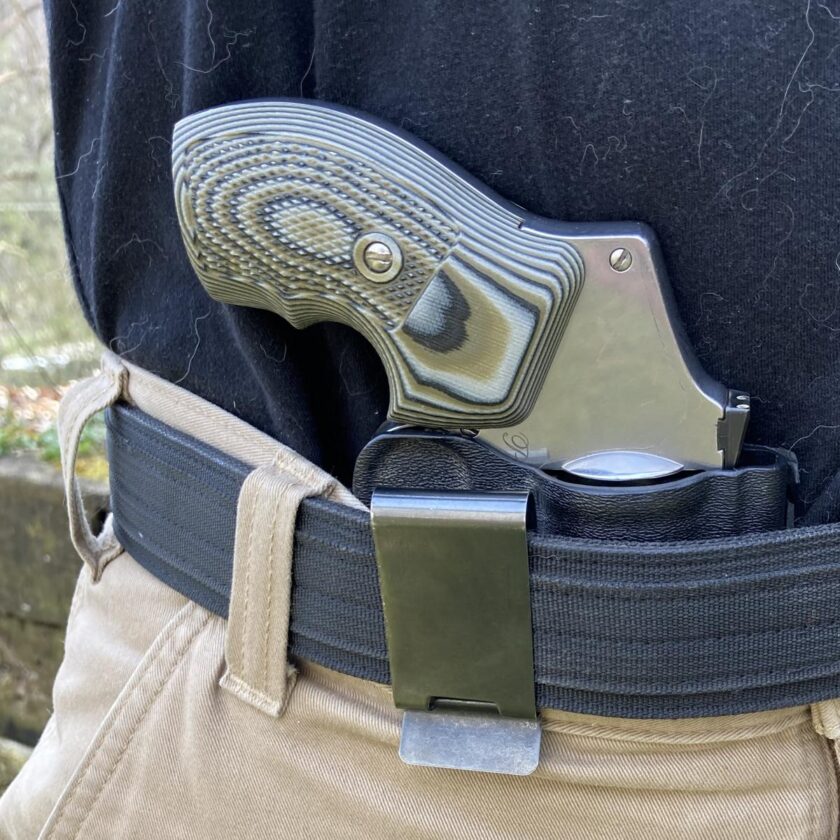
Some holsters will have an adjustable ride height. Adjustable doesn’t mean “infinitely adjustable” – it just means you might be able to tweak the holster a bit this way or that. Sometimes a small tweak can make a huge difference. Ride height is applicable to both OWB and IWB holsters.
Cant
Cant refers to a holster’s tendency to rotate a gun’s forward a few degrees. The gun is rotated roughly at the trigger guard, pushing the muzzle back toward the rear slightly, and rotating the butt of the gun forward. This helps with concealment by getting more of the gun inline with the body’s horizontal axis. Some like some cant and some don’t. Cant can certainly aid concealment but it can also slow one’s draw slightly.
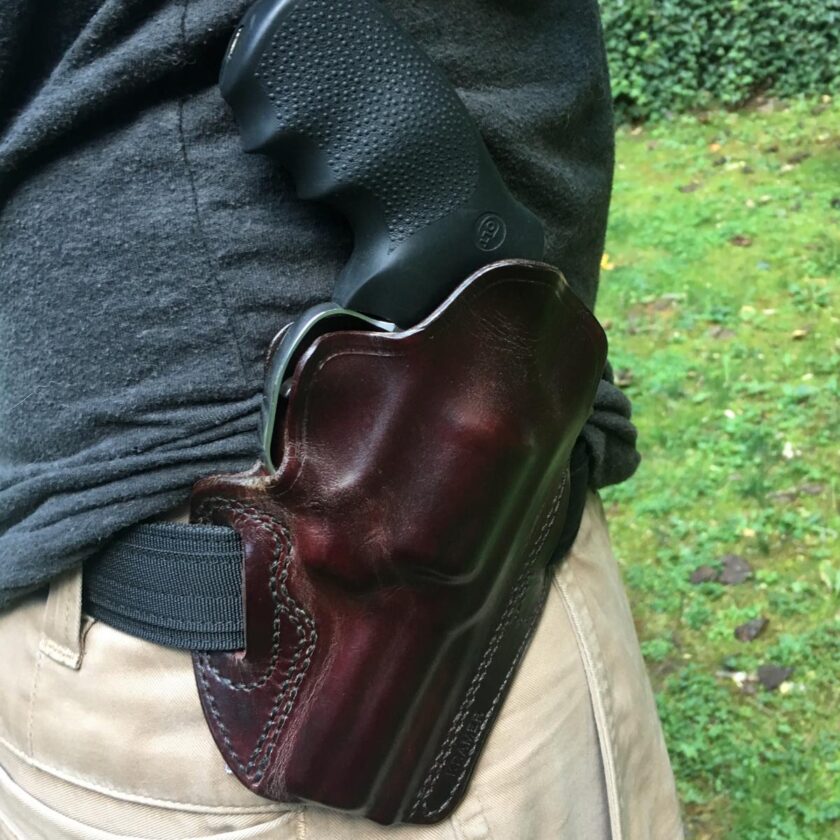
Cant typically applies to OWB holsters, but can also apply to some IWB rigs. The great majority of AIWB holsters will have a neutral cant (i.e. will ride straight up and down).
Sweat Guard
Some holsters may feature a sweat guard. A sweat guard is simply an upward extension of the holster material (plastic or leather) between the skin and the frame of the gun. The obvious, stated purpose of this is to protect the gun from sweat. That is an important function the sweat guard serves – your firearm will cause your to sweat and will corrode because of it if not kept clean and lubricated, especially in warmer months and warmer climates.
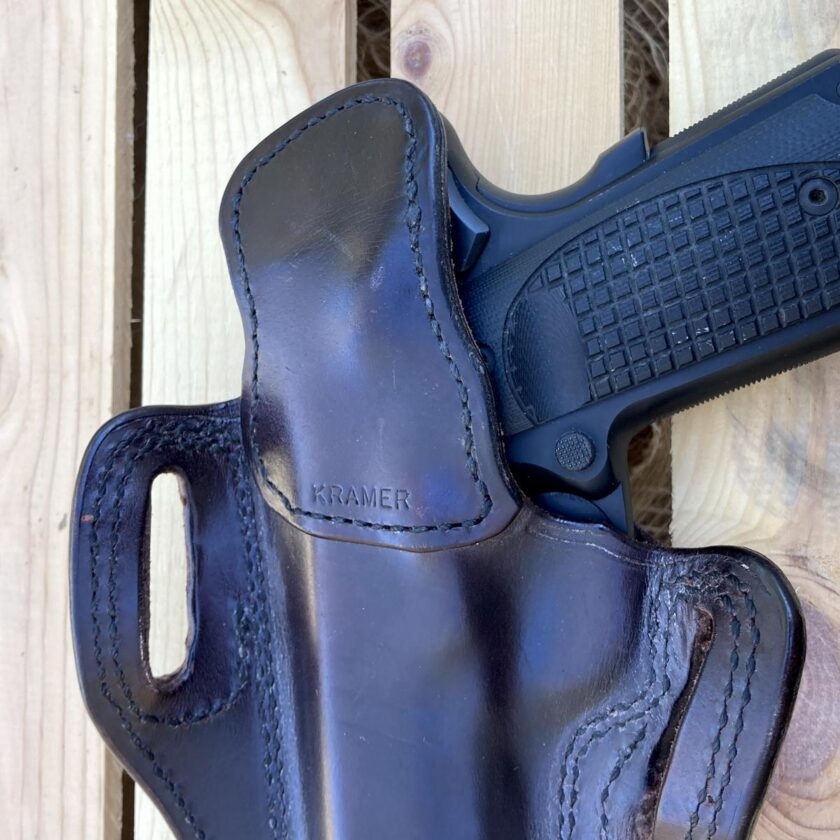
Another function of the sweat guard is comfort. Some guns have pointy things (safeties, decockers, hammers) at or near the rear of the slide. A sweat guard can keep those features from digging into your skin. A good sweat guard can protect both the gun and the wearer by making a handgun massively more comfortable.
Sweat guards can also have a downside, especially if not executed well. A too-large sweat guard can interfere with a clean draw. I don’t own a bad example of a sweat guard that I can show you here, but a bad one would extend into the grip area. This would require the wearer get his or her hand between the gun and the holster to draw. This slows the draw considerably, and raises the chances of a sloppy grip upon presentation.
Wings and Things
Some inside-the-waistband holsters, especially appendix inside-the-waistband (AIWB) holsters will feature a protrusion on the trailing edge (the trigger side of the holster). This protrusion is designed to be pressed inward by the belt, rotating the butt of the gun inward toward the body. These can aid greatly in concealment and by reducing printing, sometimes considerably so. Below is a M&P Shield Plus carried in a holster lacking any sort of wing. Note how the butt of the pistol sticks out from the body. It isn’t a lot, but it’s enough to snag on a t-shirt and enough to print a little bit.
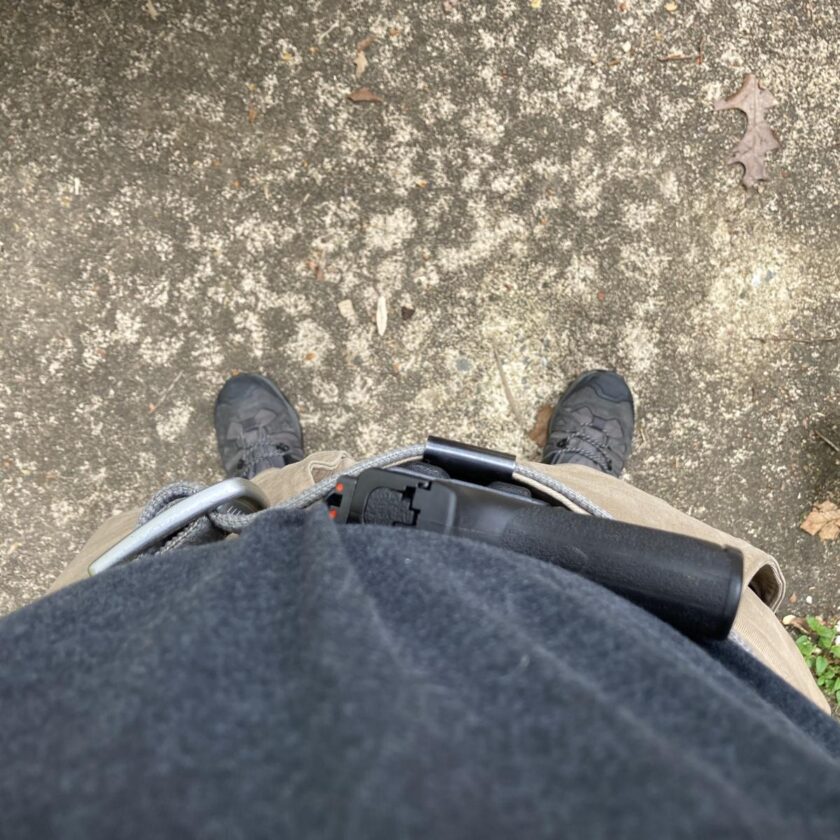
Now look at the exact same holster/exact same gun again. The only difference is that a wing has been installed on the holster. Note how tightly to the body the gun’s grip is. Honestly at this point it is very difficult NOT to conceal this gun/holster combo. This photo also does a good job of illustrating exactly how a wing-type device works.
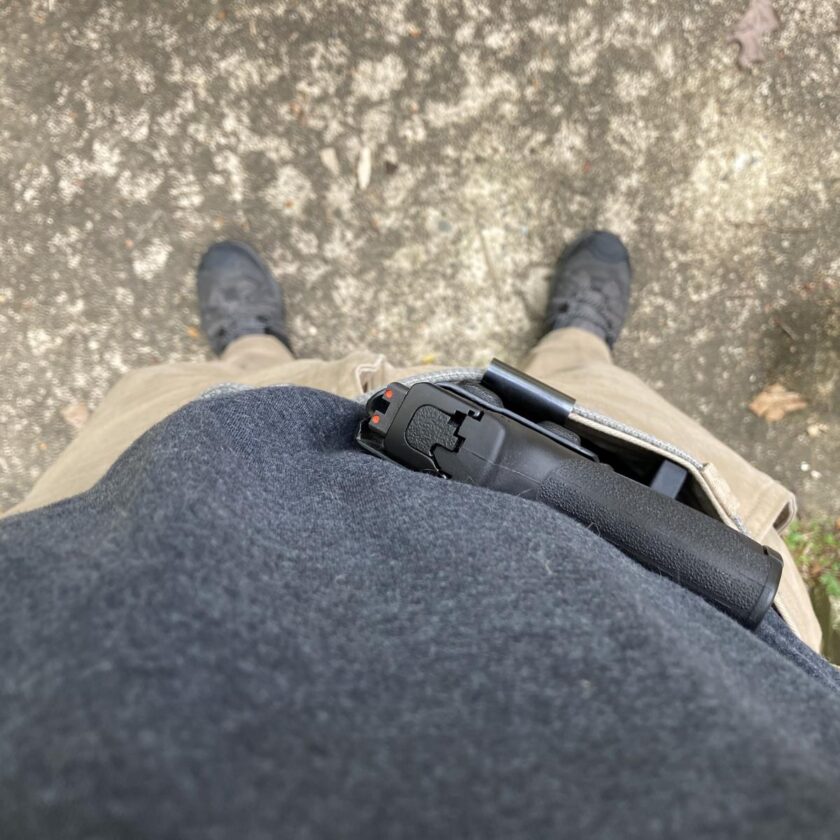
These take several different form factors. Sometimes they are simply a raised portion of Kydex on the holster itself as shown below.
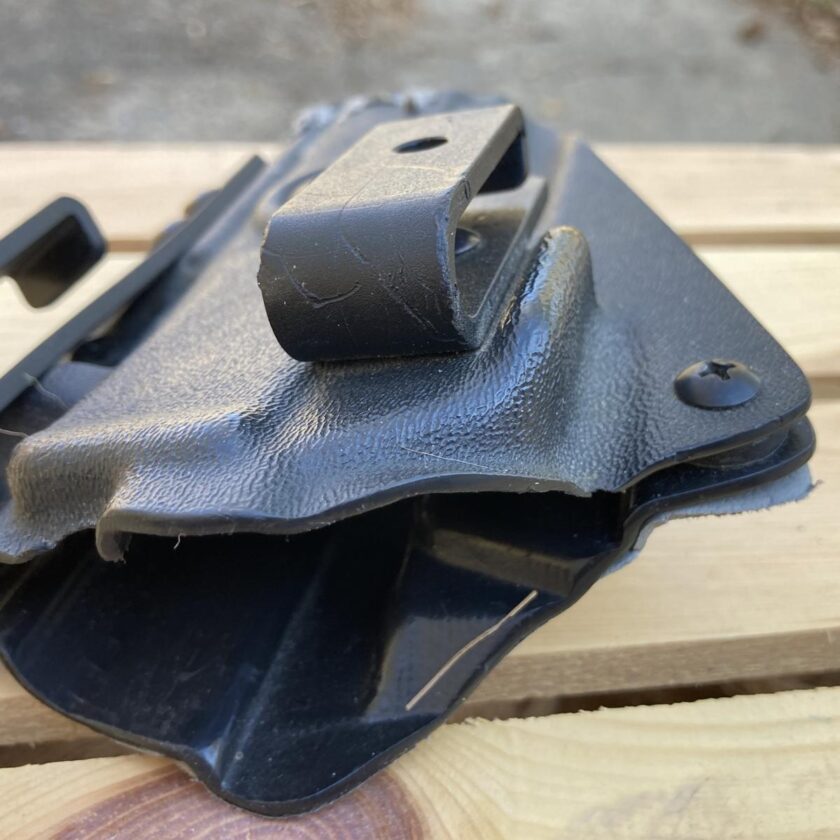
Sometimes it might be an add-on to the holster like the Tulster Sidekick. I have added a sidekick to both a Tulster holster that came with a used gun I purchased, and to a Dark Star Gear holster and overall I find it does a pretty good job.
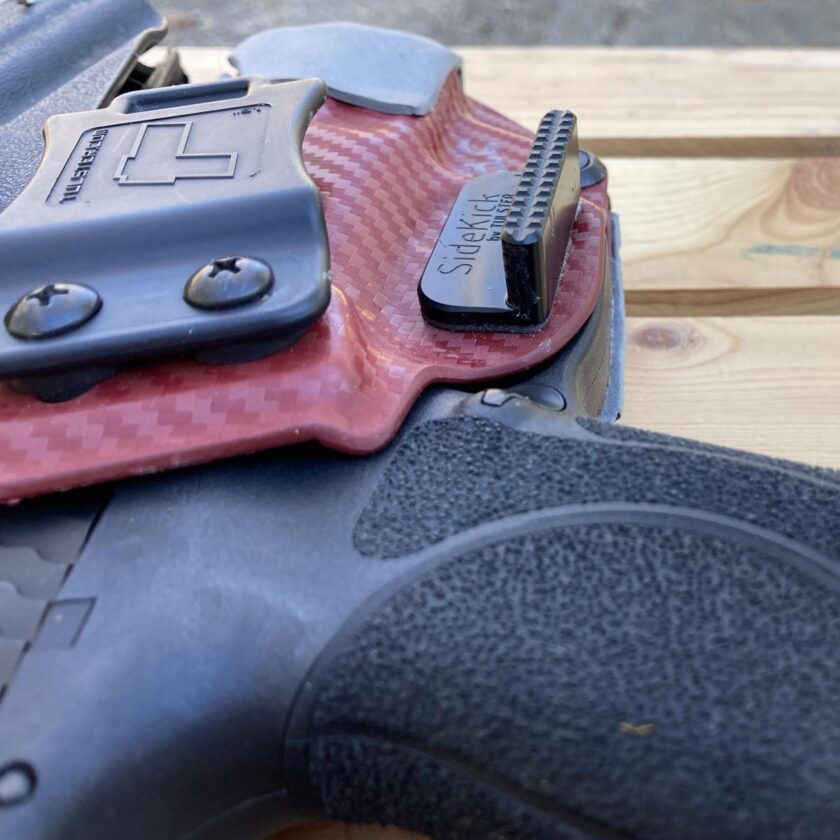
There are also “wings” that protrude off the rear side of the holster. Again, these do the exact same thing – they take pressure from the belt and rotate the gun rearward. The PHLster Pro Series and most holsters from Dark Star Gear provide excellent examples of wings, but they are far from the only ones on the market. The Dark Star Gear holster below is equipped with a Dark Wing attachment, and was the holster used to demonstrate how a wing works.
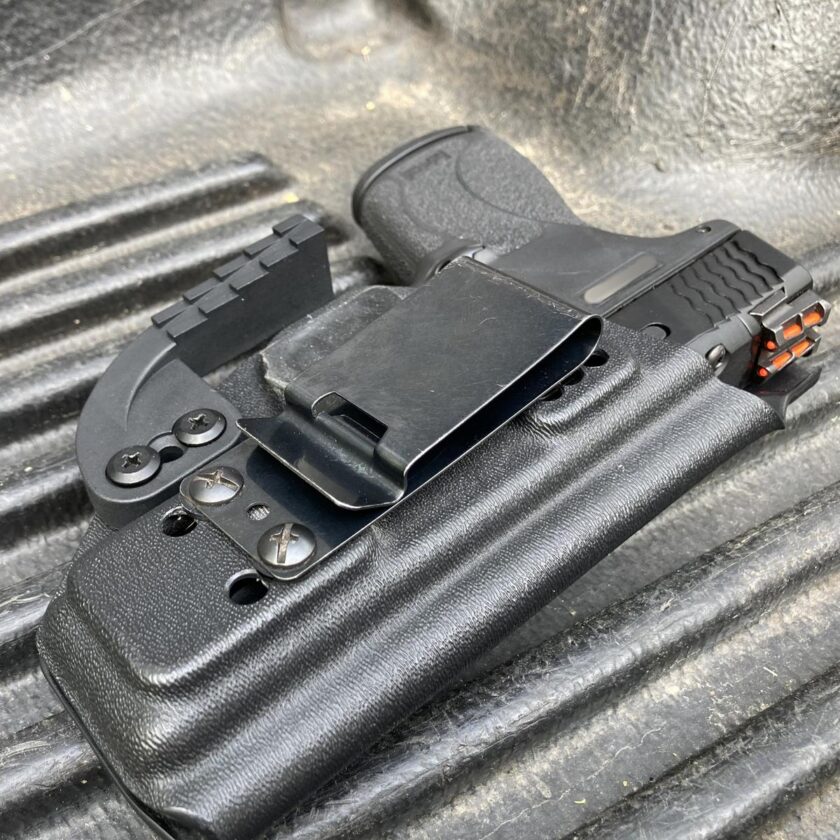
Pads and Doo-Dads
Appendix inside-the-waistband holsters sometimes come with some sort of pad attached near the lower end of the holster (near the gun’s muzzle). This extra material pushes the muzzle out, which rotates the gun’s butt back toward the wearer’s body, aiding concealment. It also has the added benefit of providing some comfort. Below are three photos of the same gun/holster combination: a S&W M&P9 2.0 carried in a Keepers Concealment Keeper. the first photo shows the triangular, wedge-shaped piece of foam.
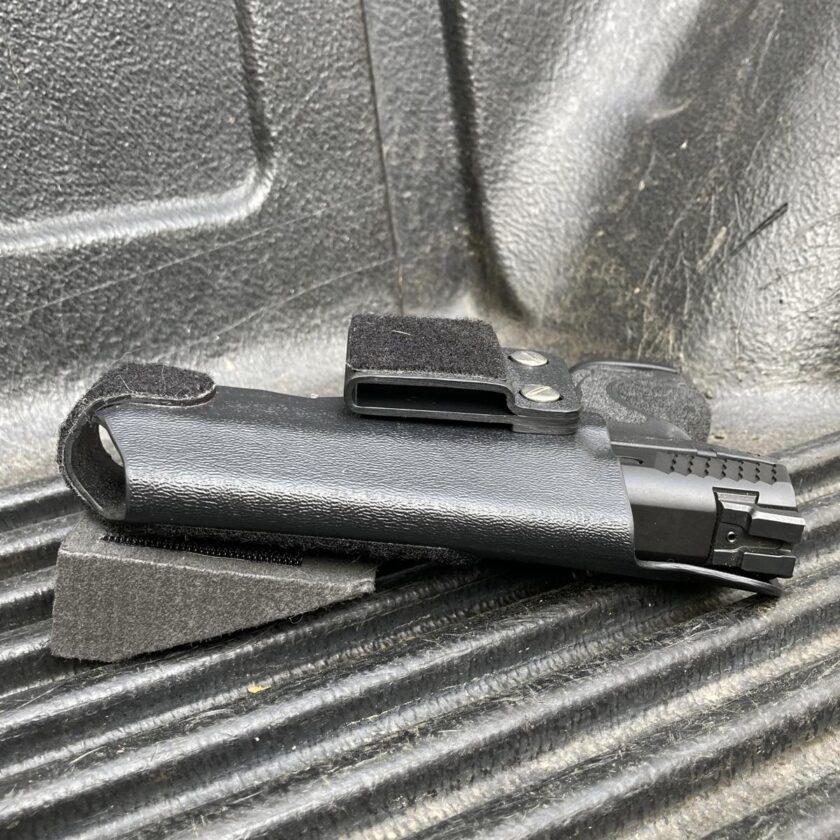
In the second shot the holster is in the belt but not equipped with a pad. Note how the pistol’s grip tends to lever out, away from the body. This tends to cause the cover garment to “pile up” on the back of the grip, creating really visible printing.
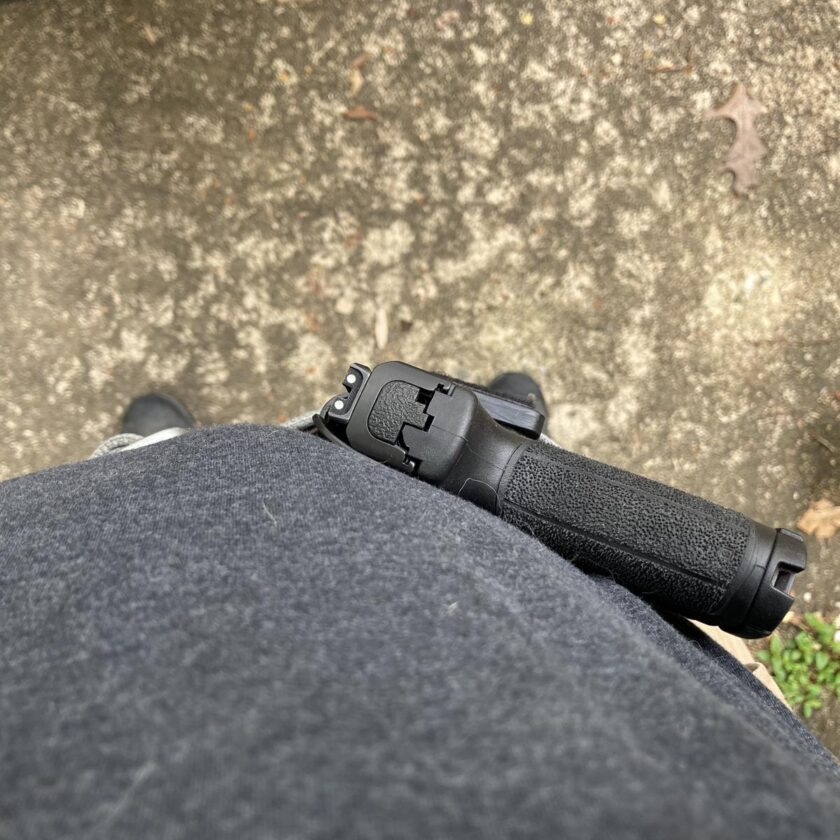
Now check out the same gun/holster combination with a pad in place.The butt of the gun is pushed back much more tightly to the body. This is a huge help in concealing a pistol.
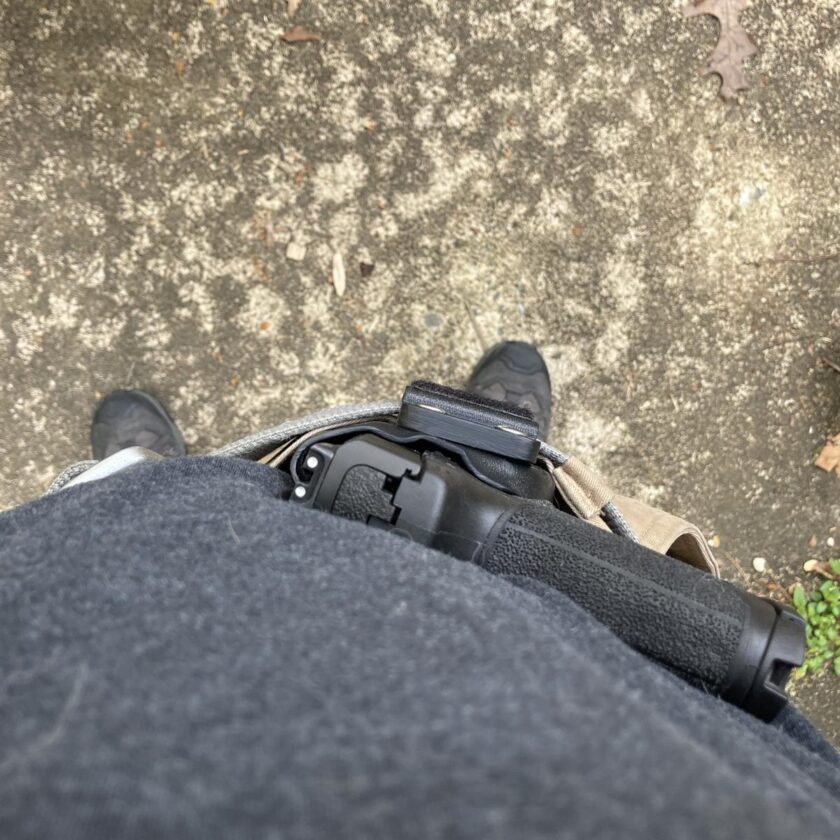
Another example: the holster from JM Custom Kydex below has a small foam pad right at the holster’s muzzle area. Sometimes a muzzle wedge is a feature that is molded directly into the Kydex. This is the case with many PHLster holsters like their Pro Series. Note the big bulge on the lower portion of the holster.
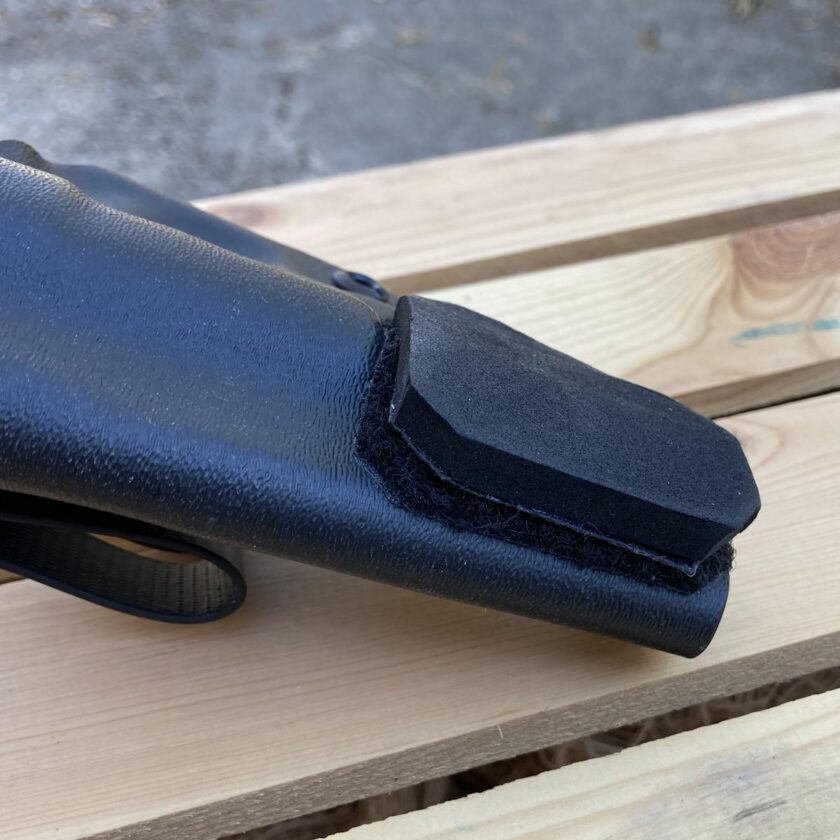
If your holster is not equipped with some sort of pad or wedge you can often retro-fit one. The items shown below are sold by Dark Star Gear as a way of adding a pad to their existing holsters. This is a great way to improve an otherwise good AIWB holster.
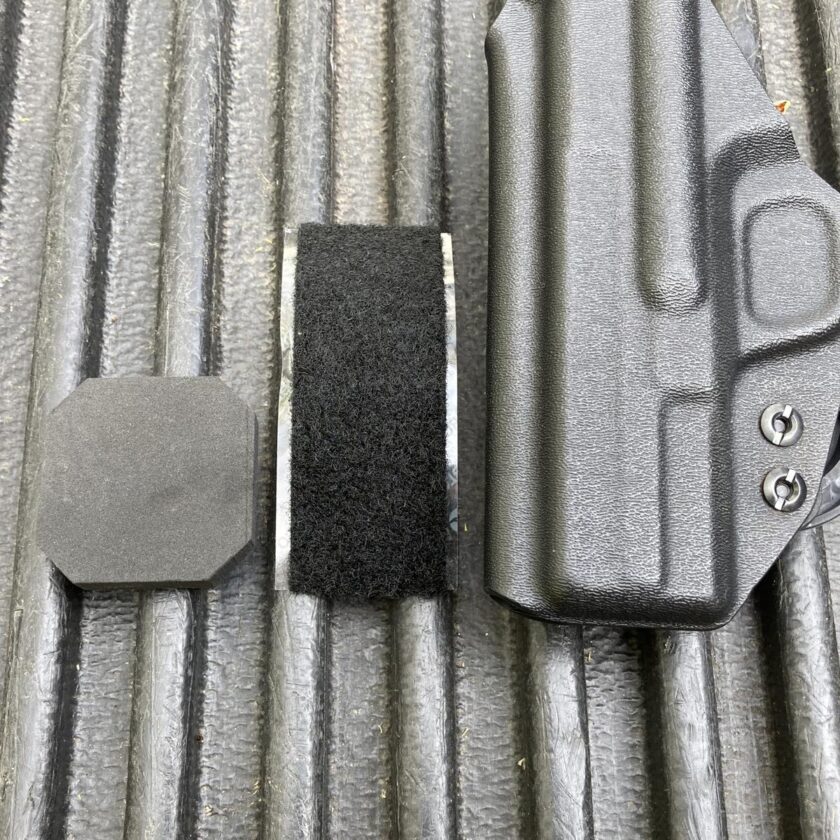
Specialty Holsters
There are some viable modes of carry and styles of holster than don’t fall into any of the above. These are usually for very specialized purposes; the holsters described above will satisfy the vast majority of concealed carriers. These are worth briefly mentioning, however.
Pocket Carry
This is a viable technique when no other carry options are available to you. It has the benefit of being convenient, and allowing you to have your hand on your gun without alerting anyone. The downsides are that you can only carry a very small gun and if your hand is not already in your pocket you will have a fairly slow draw. If you choose to pocket carry you should use a pocket holster. There are a few reasons for this. The first is safety; your trigger may be actuated in your pocket if not protected by a holster. You should absolutely use a pocket holster if pocket carrying.
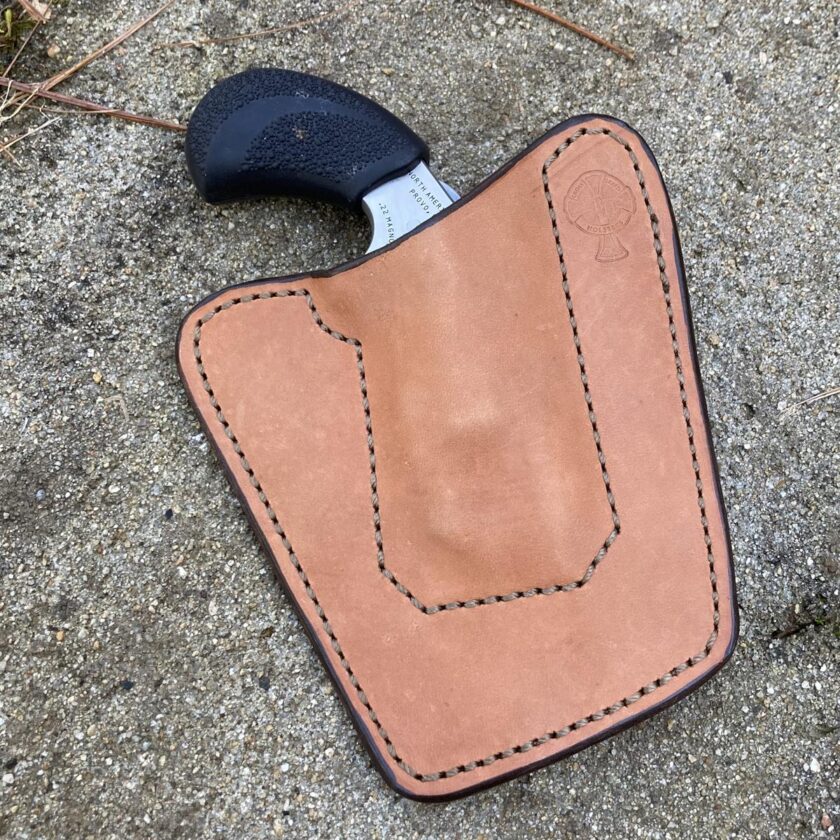
Secondly, a pocket holster will hold the gun upright in a consistent position. Otherwise the gun will very likely “float” around in your pocket. If you go to retrieve it in a hurry you are unlikely to find the grip where you expect to find it. This is especially dangerous in combination with the fact that the trigger is not protected. Finally, a pocket holster will break up the outline of the gun, helping to conceal it. As I said, I would not consider pocket carry unless no other option exists; it’s what my buddy Mike uses to, “carry a gun when [he] can’t carry a gun,” meaning it will do when no other option is available.
There are several really good pocket holsters out there. The most appropriate answer for most people is the DeSantis Nemesis or DeSantis Superfly. Both of these are soft, padded, have a grippy exterior (so the holster stays in the pocket), and both are very inexpensive. Pocket holsters are also available in leather, like the Crossbreed holster shown here. If you require something more robust there are excellent Kydex options, too, like the Vedder Pocket Locker.
Ankle Carry
Ankle carry, too, is a viable option in some circumstances and again, it requires a specialized holster. It has the benefit of providing an easy draw from the seated position. This may be desirable for individuals who spend the majority of their day sitting, whether at a desk or in a car. Ankle carry also gets the gun off the waistline. Your attacker may go for a more obvious site like the waistline. For this reason (and others) ankle carry is a good option for a backup gun. Unless your circumstances contraindicate pretty much every other means of carry I would avoid ankle carry for general use.
Ankle carry has tremendous downsides. Ankle carry requires that you either sit, bend at the waist, or take a knee to draw. This can make you very vulnerable in a fight for your life. You also have to get your pants-leg up over the gun which can be difficult with stiff pants like jeans and the bulk of a firearm. All of this is really slow compared to drawing from a belt holster. Remember, you’re probably not going to get a long heads-up to prepare when you truly need your firearm. Ankle carry doesn’t permit the carry of large firearms – you’re generally limited to very small guns.
If you have to run (something that sometimes happens when people try to kill each other) your gun is subject to a lot of motion; unless it is properly secured it might come out. This has happened to more than one law enforcement officer carrying an ankle holstered backup gun. You can avoid this by using a high-quality ankle holster like the Galco Ankle Glove, and by using the lightest handgun possible. Again, outside of specialized use-cases like carrying a backup gun I would avoid ankle carry unless it is honestly the only feasible option for you due to extenuating circumstances.
Other Specialty Holsters
I certainly haven’t covered every holster-style and carry method represented on the market. There are a number of other peculiar styles, designs, and features out there. Many of them are really good when indicated, but may only be applicable to a narrow band of situations or circumstances. A great example is the PHLster Enigma, a very specialized holster that is getting rave reviews from people I respect and trust.
Many of these specialty holsters usually don’t differ significantly in their underlying carry mode (they are normally strong side hip) but meet other specialty criteria. Specialty holsters may accommodate a pistol with a weapon-mounted light. They may be designed for overt/open carry on a battle belt or competition rig. Some may be chest-rigs, holster fanny packs, or other oddball carry methods.
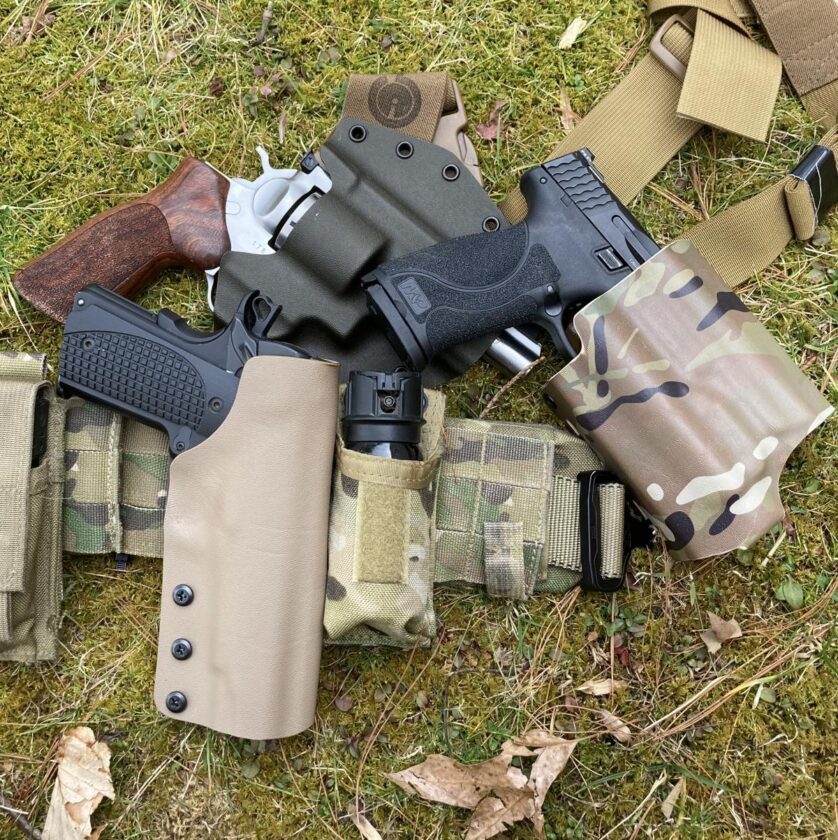
There are good reasons for some of these holsters. If you are seeking your first handgun holster, I recommend sticking with a more tried-and-true design, like a strongside OWB, IWB, or AIWB. If you get into competition, set up a home defense belt, or have some other compelling need, cross that bridge when you come to it. Prioritize a solid, high-quality, conventional holster for day-to-day use and worry about the specialized use-cases later on.
Not Recommended
There are a number of other ways that you may be tempted to carry a firearm. These methods of carry are depicted in plenty of media, including some media that should probably know better. One could probably make some case for almost all of these carry methods in certain outlier scenarios (my brother-in-law was a undercover…). Generally speaking and without some compelling reason otherwise, these carry methods are discouraged.
Off-Body Carry
I see this one more than any other carry method listed here: carrying a firearm around, but not on one’s body. The most common method of concealed carry where I live currently is in one’s vehicle. Other common ways to carry are in backpacks and purses. There are multiple problems with off-body carry. First, the firearm is not on your body. Being in a backpack or purse it is exceptionally slow to draw. Being stored in a vehicle is is not where you need it when you’re most likely to need it (when you’re out of the vehicle). You lose the entire benefit of access when the gun is not on your body.
Second, and perhaps more importantly, the firearm is not as secure as when it is on your body. Purses can and sometimes are snatched, including by thieves who will cut the strap off your shoulder. This would result in not only the loss of your means of defense, but also in arming the criminal. Backpacks and purses get sat down and hung on the backs of chairs. Occasionally (as is the case with a family member of mine) purses get completely forgotten in restaurants. And purses and backpacks are often accessible to your children. There are a lot of really good reasons to avoid off-body carry if you can possibly help it. If you’re still not convinced that purse carry is a bad idea, please read this article…and this one, both from Lucky Gunner.
In the case of storing a firearm in a vehicle…there are a good number of reasons not to. First, your firearm is completely out of your control for a good portion of the day. Anytime you are out of your vehicle your firearm is susceptible to theft. Second, your children probably have access to your vehicle. No matter how well-trained they are to leave firearms alone, would you bet their lives that they would never play with a gun if they found one in your car? I wouldn’t take that bet with anyone’s kids. Thirdly, in the event you are carjacked or, for some other reason need your gun while in your car, it’s not as accessible to you as it would be in a holster on your body. Fourth, if you get in an accident is your firearm secured in the vehicle? If not, where is it going to end up if you get in a serious accident?
If you are going to carry a firearm off-body (I don’t think you should, but *if*), I strongly recommend putting it in some sort of holster with good trigger protection and good retention. You certainly don’t want a gun floating around in your bag with no trigger protection. Pens, lipstick, cigarette lighters, even folded paper may contact the trigger and depress it enough to cause the gun to fire. A high-quality holster may prevent this. I also strongly recommend considering your carry condition (i.e. chamber-empty carry).
Cross-draw/Shoulder Holsters
I am lumping these two in the same category because they both require a similar motion to draw. One has to reach across his or her body, draw, then come back across the body to the strong side to fire. The cross-draw or shoulder holster is often touted for those who have to spend long hour sitting. It is easy to draw across the body while seated. It also comes with some problems. First, it is slow – certainly slower than drawing from a good IWB or OWB holster. Second, the shooter is likely to “over”-draw and swing past the target, a common problem when drawing with this type of holster. That further slows the employment of the firearm. This type of holster also presents the butt of the gun in the ideal location for an attacker to draw it.
Unless you have a really compelling reason for choosing a crossdraw or shoulder holster, I’d stick to a strong side IWB or OWB. If you want to read a bit more about this style of holster, Greg Ellifritz recently wrote a detailed article covering the pros and cons.
Small-of-the-Back (SOB) Carry
This is one carry methodology that I do not recommend at all. I can’t imagine a plausible scenario where this is the only viable carry option. I can’t think of a single “pro” for small-of-back carry that would make it desirable, except maybe that it looks cool to neophytes. Please avoid small-of-back carry. There are myriad disadvantages to this style of carry. The only potential advantage I can think of is comfort. I have not carried in this position so I don’t know that it is any more comfortable than anything else but it must have something going for it. Let’s look at the downsides.
Small-of-the-back carry places the gun directly over your spine. If you take a fall your are going to land on an unforgiving metal object. This has a very high likelihood of damaging your spine and/or pelvis. I would not carry SOB for this reason alone. Second, drawing from SOB safely is difficult. When you grasp the gun and draw it, your hand must rotate around to get the gun turned around toward the target. It is very difficult to do this without pointing the gun directly at yourself. This is also much slower than drawing from a traditional holster. It is also difficult to draw if you find yourself grappling with someone and you are on your back. You have to get your arm behind you, and get it under your body and get the gun out.
Small-of-the-back holsters are very difficult to defend from gun-grabs. If someone knows you have a gun (maybe your shirt rode up when you bent over – something that happens with this type of carry) and someone saw your gun. If they go for it you have to defend something that is behind your back. This is way, way, way more difficult than defending a gun that is in front of you, or even on your side. And holstering the gun safely, i.e. without pointing it at yourself is difficult. I would avoid carrying SOB at all costs.
Open Carry
And finally we get to open carry. Open carry may be an option for you, depending on the laws where you live. Open carry has some facets that make it attractive. Often, you do not have to obtain a concealed carry permit to carry openly. This alone is enough reason for some people to carry openly. Open carry is probably more physically comfortable, and you can probably carry a bigger gun much more easily. Again, though, there are significant downsides to open carry.
First, many people assume that open carry deters criminals. There is a mindset among some of you out there that be seeing a gun a criminal will be afraid of you and leave you alone. I think there is pretty compelling evidence that this is not the case. There are numerous examples of open carriers having their firearms taken away. There are a few examples of the firearm then being used to murder them. Second, you preemptively give up any element of surprise. By broadcasting your state of armament you are ceding your element of surprise and now making yourself the potential victim of surprise.
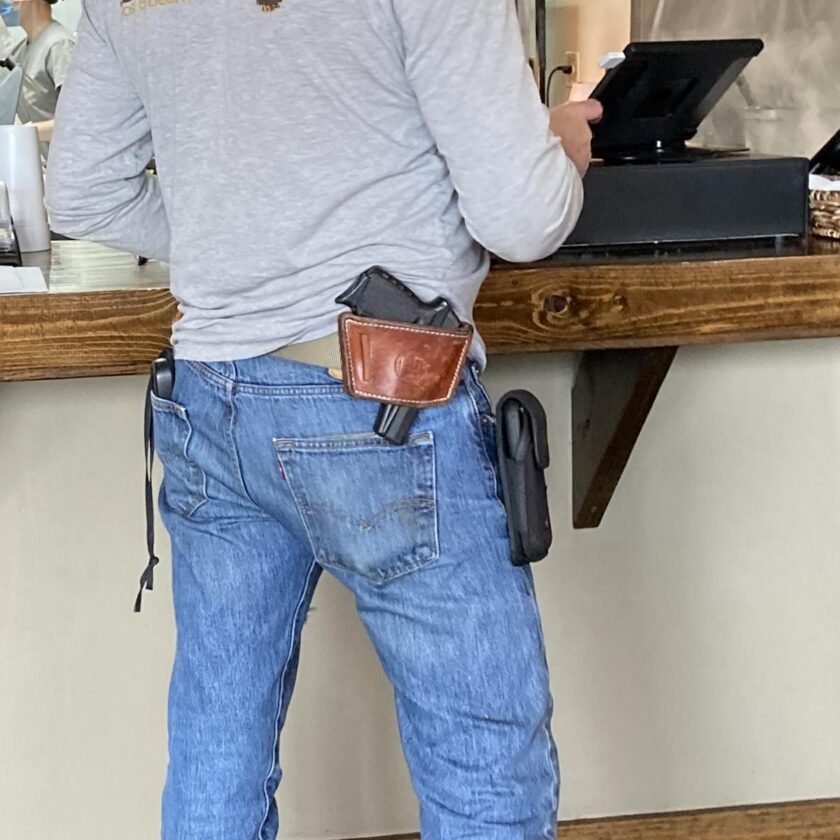
Next – and some of you will scoff at this one – you will make people uncomfortable. I wouldn’t worry about their discomfort per se, but I would worry about its consequences. Though some of you desperately do, I don’t need or want to be the center of attention. I don’t need everyone to look at me as I walk by. I certainly do not want to be the subject of a “man with a gun” call to the police. I’m sure there are plenty more reasons to avoid open carry but these are the most obvious.
If you must open carry, do so with high-quality equipment. First, you need a strong belt and a holster that attaches firmly to it. Paddle holsters (not recommended for several reasons) can be yanked right off of your belt. Belt loops on cheap holsters can be ripped right off, too. And, of course, cheap belts can be broken as well. If carrying openly choose the best equipment you can possibly afford. I also highly recommending using a retention holster. Holsters have varying levels of retention from simply friction all the way up to multiple devices that must be defeated before the gun is released. Retention levels can be somewhat confusing (this article from my friend Mike Wood might help), but I recommend a holster with at least one active retention device.
As Spencer Keepers (of Keepers Concealment) is now somewhat well-known for saying of open carry, “I support the right but not the practice.” I couldn’t agree more.
Closing Thoughts
Holster selection truly is daunting. I hope this has helps someone in the search for his or her first holster. I’m sure I’ve overlooked something, covered something inadequately, or completely missed something; if that is the case feel free to let me know.
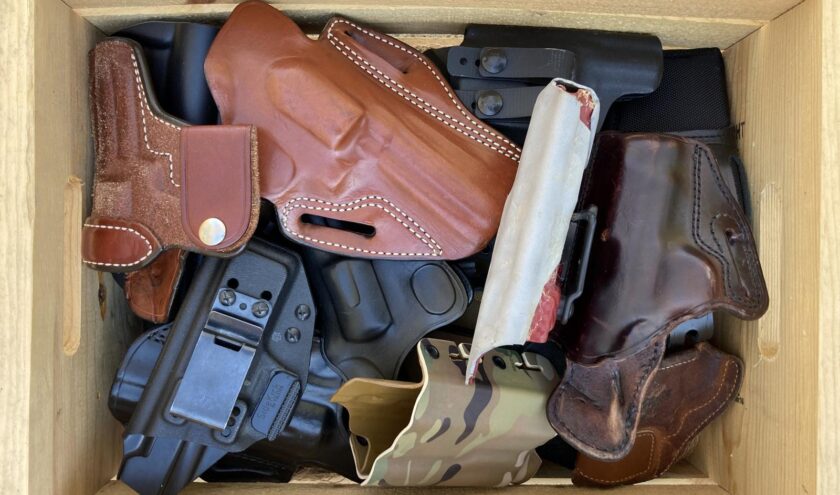






1 thought on “Gun Owner 101: Holster Selection”
Comments are closed.